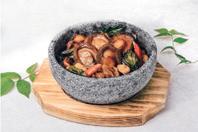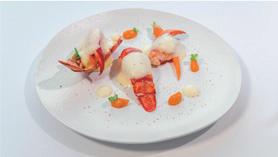EXPERT TALK
TRADITIONAL NOODLE MAKING
URBAN WALKS
MRT ZHONGSHAN STATION NEIGHBORHOOD

Smangus – “God’s Tribal Village”
Hsinchu City Center and Coast
Three Themed Tours




EXPERT TALK
TRADITIONAL NOODLE MAKING
URBAN WALKS
MRT ZHONGSHAN STATION NEIGHBORHOOD

Smangus – “God’s Tribal Village”
Hsinchu City Center and Coast
Three Themed Tours



Experience creating various styles of Han Pastry in hands-on DIY
Han Pastry, a conduit for exchanging pleasantries and a sweet indulgence enjoyed in the company of family and friends
To foster a deeper appreciation for the value and cultural significance of Han Pastry (traditional pastry), Jiu Zhen Nan, Taiwan's premier brand of Han Pastry, is offering pastry creation classes at select locations, including the Regent Taipei hotel, our Tainan flagship store, and the Jiu Zhen Nan Han Pastry House. These classes cater not only to locals but also to foreign tourists visiting Taiwan, providing each with the chance to engage in a handson, authentic Han Pastry-making experience.
Each season, pastry-making classes are offered that are tailored to incorporate traditional festival delicacies, featuring beloved classics like Mung Bean Cake, Sun Cake, and Pineapple Cake. You will uncover captivating, innovative designs in Chinese pastry artistry, ensuring a delightful and memorable experience with a profound sense of accomplishment. Upon completion of a class, relish the distinct flavors and delightful tastes of Han Pastry, indulging in a delightful moment of cake and tea.
Book now to discover the story behind Han Pastry and savor the exquisite flavors of Taiwan!


135th Anniversary Celebration: Taiwan's Exclusive Han Pastry Exhibition
This year, we commemorate the 135th anniversary of Jiu Zhen Nan. An exclusive exhibition featuring Han Pastry will be on display at the Jiu Zhen Nan Han Pastry House starting in June 2024. The exhibition presents historical and cultural narratives surrounding Han Pastry, giving visitors a profound sense of Han Pastry's integral role in daily life, and fostering a deep appreciation for and helping to preserve this invaluable cultural treasure.
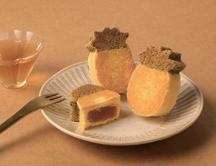


Zhongshan N. Rd., Zhongshan Dist., Taipei City 10am~9pm regent@jznpastry.com
TAINAN FLAGSHIP STORE (06) 238-7666 No. 184, Sec. 2, Linsen Rd., East Dist., Tainan City 9:30am~9pm tn@jznpastry.com


ZHEN NAN HAN PASTRY HOUSE (JZN COOKING LAB) (07) 701-8586 No. 298, Jiexi Rd., Daliao Dist., Kaohsiung City Tue.~Sun. 10am~6pm pastryhouse@jzn.com.tw


Dear Traveler,
Traveling in Taiwan in the summer is a breeze – especially in our visually stunning, breeze-swept hilly and mountainous regions, which cover about two-thirds of the island. In this issue, we’re spending a good deal of time in the wave-shaped rolling hills, and we’re also introducing you to the iconic “cool eats” that locals rush to to beat the high summer heat.
In each issue of Travel in Taiwan, we give readers three feature articles on a single Taiwan region, thereby providing you with a more in-depth overview. This round it’s Hsinchu county and city, in the island’s northwest. In our main feature, discover forest walks, indigenous villages, and other gems in mountainous deep-inland Jianshi Township, particularly Taiwan’s most remote tribal settlement, Smangus, which operates as a cooperative hosting tourists, most of whom stay there overnight.
You’ll spend another article right on the coast, in centuriesold Hsinchu City. Our writer is your guide on a day trip, taking you along its streets “hunting for history,” visiting a “market-ensconced temple,” and breezily “cycling towards the sunset.” Finally, you’ll spend time in the hill territory between these two exploring the distinctive culture of Taiwan’s Hakka population, visiting two renowned touristbusy old Hakka towns, Beipu and Guanxi, and learning about three tasty Hakka culinary classics, rice noodles, aged fruit tea, and dried persimmons.
The destinations in our other major articles are all in the northern part of the island, in and around Taipei. In our regular Urban Walks file we dive into the popular shopping area around the Taipei Metro’s Zhongshan Station, teeming with cultural-creative shops and food/drink providers, glittery large-scale retailers, and a narrow blocks-long linear park wonder-filled with imaginative public art.
In Good Food dig into the icy treats that keep Taiwan folk cool and fresh in the sultry summer months, visiting a special selection of well-known Taipei and New Taipei City shops creating shaved-ice treats, ice creams, and popsicles with quintessential Taiwan-character flavors. And in Expert Talk head into the low mountains southeast of Taipei to a workshop where you can try your hand at crafting traditional-style mianxian noodles.
Enjoy your time with us on our island home, cooled by waves of ocean-sent breezes, learning why the Tourism Administration has chosen Taiwan – Waves of Wonders as our new international tourism-promotion slogan.
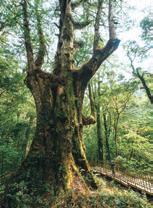
台灣觀光雙月刊
Travel in Taiwan
The official bimonthly English magazine of the Taiwan Tourism Administration (Advertisement) JULY/AUGUST, 2024 Tourism Administration, MOTC First published Jan./Feb. 2004 ISSN: 18177964 GPN: 2009305475 Price: NT$200
中華郵政台北雜字第1286號執照登記為雜誌交寄 Copyright @ 2024 Tourism Administration. All rights reserved. Reproduction in any form without written permission is prohibited.
MAGAZINE IS SOLD AT:
1. Wu-Nan Culture Plaza, No. 6, Zhongshan Rd., Central Dist., Taichung City 40043 886-4-2226-0330 http://www.wunanbooks.com.tw/
2. National Bookstore, 1F., No. 209, Songjiang Rd., Zhongshan Dist., Taipei City 10485 886-2-2518-0207 http://www.govbooks.com.tw/
PUBLISHER
Taiwan Tourism Administration
EDITING CONSULTANT
T. C. Chou
PUBLISHING ORGANIZATION
Taiwan Tourism Administration, Ministry of Transportation and Communications
CONTACT
International Division, Taiwan Tourism Administration Add: 9F, 290 Zhongxiao E. Rd., Sec. 4, Taipei City, 10694, Taiwan
Tel: 886-2-2349-1500 Fax: 886-2-2771-7036
E-mail: tad@tad.gov.tw Website: http://taiwan.net.tw
PRODUCER
Vision Creative Marketing & Media Co.
ADDRESS
1F, No. 5, Aly. 20, Ln. 265, Sec. 4, Xinyi Rd., Taipei City 10681, Taiwan
Tel: 886-2-2325-2323 Fax: 886-2-2701-5531
editor@v-media.com.tw
GENERAL MANAGER
David Hu
EDITOR IN CHIEF
Johannes Twellmann
ENGLISH EDITOR
Rick Charette
DIRECTOR OF PLANNING & EDITING DEPT
Joe Lee
MANAGING EDITOR
Anna Li
EDITORS
Masako Takada, Ruby Chang
CONTRIBUTORS
Ami Barnes, Rick Charette, Ash Boden, Han Cheung
PHOTOGRAPHERS
Chen Cheng-kuo, Ray Chang, Powei Chen
DESIGNERS
Ian Tsai , Hsieh Yun-jhen , Nina Yang
ADMINISTRATIVE DEPT
Lily Wan, Hui-chun Tsai, Xiou Mieng Jiang
ABROAD
Offices of the Taiwan Tourism Administration in Beijing, Shanghai, Hong Kong, Singapore, Bangkok, Ho Chi Minh City, Kuala Lumpur, Seoul, San Francisco, New York, Los Angeles, Frankfurt, and London. Overseas Offices of the Ministry of Economic Affairs; Overseas Offices of the Central News Agency; EVA Air, and other selected international airlines; selected travel agencies in Asia, North America, and Europe; and other organizations.
IN TAIWAN
Tourism Administration Visitor Center; Tourism Administration; Taiwan Visitors Association; foreign representative offices in Taiwan; Tourism Administration service counters at Taiwan
Taoyuan Int’l Airport and Kaohsiung Int’l Airport; major tourist hotels; Taipei World Trade Center; VIP lounges of international airlines; major tourist spots in Taipei; visitor centers of cities and counties around Taiwan; offices of national scenic area administrations; public libraries
This magazine is printed on FSC® COC certified paper. Any product with the FSC® logo on it comes from a forest that has been responsibly maintained and harvested in a sustainable manner.
This magazine was printed with soy ink. Soy ink is said to be more environmentally friendly than petroleum-based ink and to make it easier to recycle paper.
ONLINE
Read Travel in Taiwan online at www.travelintaiwan.net. Find back issues (PDF version) on the publication platform issuu at issuu.com/travelintaiwan




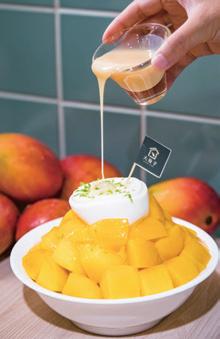
HSINCHU COUNTY / JIANSHI TOWNSHIP
AMONG ANCIENT GIANTS
Forest Walks and Indigenous Villages in Hsinchu’s Jianshi Township
COOL EATS
Chilled Delights to Keep You Refreshed Under the Taipei Sun
HSINCHU COUNTY / URBAN CENTER & COAST
BICYCLES, BITES, AND A BOARDWALK
A Day-Tripper’s Guide to Getting the Most Out of Hsinchu City
LITTLE THINGS / FRUITS
JUICY TAIWAN
Sweet and Healthy Fruits Throughout the Four Seasons
THE HAKKA OF HSINCHU
Tourist-Friendly Towns, Classic Culinary Gems
BOUNCY AND CHEWY
Traditional Noodle Making in New Taipei City’s Shiding District
WEST TAIPEI’S TRENDY CORNER
Exploring

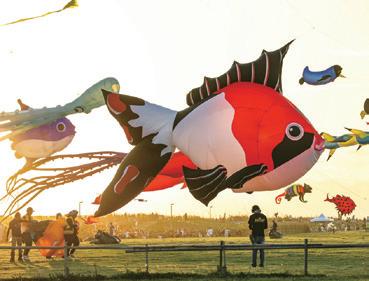

KEELUNG COUNTY 1
August
KEELUNG MID-SUMMER GHOST FESTIVAL
This event, lasting a full month, is one of Taiwan’s major annual festivals. It takes place during the 7th lunar month (August 4~September 2 in 2024), referred to as “Ghost Month.” According to folk belief, at this time of the year, the gates separating the realms of the living and the dead open and ghosts return to wander the earth. To appease these wandering souls, lavish offerings are made in front of temples in the northern port city of Keelung and a plethora of elaborate, colorful rituals and ceremonies are staged. Among the numerous highlights of the festival are the DoorOpening Ceremony at Laodagong Temple on Day 1 and the Water Lantern Parade and Releasing of Water Lanterns on Day 14 of the lunar month. tour.klcg.gov.tw
AROUND TAIWAN 2
June 1 ~ Sep. 1
SOLAR FESTIVAL IN TAIWAN
Since 2014 the Taiwan Tourism Administration (formerly Taiwan Tourism Bureau) has been actively promoting festivals and events staged during the summer months around Taiwan. On a dedicated website (see link below), you can find information about dozens of happenings, ranging from the Northeast Coast Fulong Life Festival to the Pingtung Bluefin Tuna Cultural Festival to the Taiwan International Balloon Festival. summerfestival.taiwan.net.tw
YUNLIN COUNTY 3
Aug. ~ Sep.
YUNLIN INTERNATIONAL PUPPET THEATER FESTIVAL 雲林國際偶戲節
Held annually since 1999, the Yunlin International Puppet Theater Festival is a grand celebration for puppet-theater lovers young and old. The festival takes place in Yunlin County’s Huwei Township, known as Taiwan’s center of puppet theater, and neighboring Douliu Township. Each year, local and foreign troupes conduct around 100 puppet performances, entertaining crowds with a wide range of puppet drama. Apart from the performances, visitors can enjoy a host of other activities, including exhibitions and DIY workshops. www.2023yunlinpuppet.com (2023)
TAIWAN CULINARY
台灣美食展
Each year, this exhibition held in the Taipei World Trade Center gives food lovers a comprehensive overview of what Taiwan’s culinary world has to offer, from humble night-market snack foods to opulent 5-star hotel feasts. Visitors have the chance to sample-eat local specialties, enjoy entertaining stage performances, watch skilled chefs showcasing their culinary expertise, admire intricate food art, and also delve into the rich tapestry of global cuisines.
www.tcetva.tw (Chinese)
TAIPEI CITY 5 July 13 ~ August 10
This annual festival takes place at Taipei City’s Yanping Riverside Park (Dadaocheng Wharf). It features beautifully adorned yachts, mesmerizing fireworks displays, and a tantalizing array of local and international food and drink served by the riverside. This event stands out as one of Taiwan’s quintessential summer celebrations, offering tourists a glimpse into the charm of Taipei’s historic riverside areas, including the iconic Dihua Street in the Dadaocheng neighborhood. This year’s festivities include four spectacular fireworks shows, including a grand finale, complemented by live stage performances and bustling food and cultural markets. Visitors can also embark on scenic river-yacht cruises and take romantic strolls through a captivating lightart installation corridor in the riverside park.
www.travel.taipei


TAIPEI CITY 6 June 29 ~ August 3
The Taipei Children's Arts Festival stands out as one of the city’s most entertaining summer attractions. Families eagerly gather at the festival, to enter a whimsical world specially made for children by art collectives from Taiwan and abroad. Each year, a unique theme sets the stage for exploration, inviting visitors to participate in a highly imaginative program where life lessons are ingeniously woven into creative experiences.
www.tpac-taipei.org
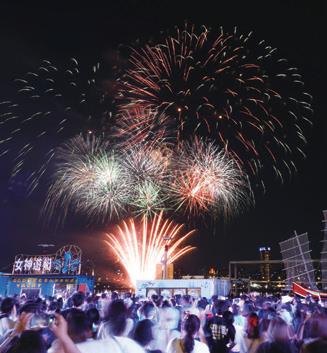
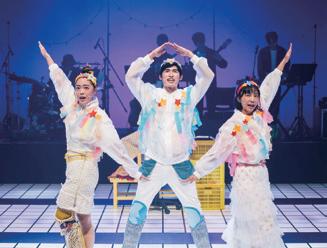

Qimei, the southernmost and fifth-largest island in the Penghu archipelago, is a popular tourist destination renowned for its picturesque Twin Hearts Stone Weir, a historic intertidal-zone fish trap. Earlier this year, the Penghu National Scenic Area Administration unveiled a new three-level visitor center on the island. This modern facility caters to the needs of the island’s many sightseers – exceeding 300,000 annually – and stands as a new Qimei landmark. Situated at Nanhu Harbor, the gateway for visitors arriving by inter-island ferry from the city of Magong via Wang’an Island, the center provides travel information and has a shop and a waiting room for travelers awaiting their ferry back to Penghu’s main islands. www.penghu-nsa.gov.tw

Since 2017, the Taipei Sightseeing Bus service has provided visitors to Taiwan's capital with a leisurely way to explore the city, offering relaxed rides that pass by many of its most iconic landmarks. In 2021, a novel approach to sightseeing bus tours was introduced with the launch of the Taipei Restaurant Bus service. Tourists have the option to enjoy lunch (braised beef noodles), afternoon tea (sandwiches and pastries), or dinner (four-course meal with chicken or beef brisket), all provided by a prestigious 5-star restaurant/hotel (currently the Taipei Regent). Differing from the open-roof sightseeing buses, the restaurant buses feature a glass roof, ensuring that the mobile dining experience remains undisturbed by traffic noise or wind and rain. This design still enables splendid views of the city's tall buildings, including the Taipei 101 skyscraper. The tours, which last between 90 and 120 minutes and are priced around NT$2,000, commence and conclude at MRT Taipei City Hall Station. Earlier this year, in addition to the original black bus, a new bus was introduced featuring a stylish gray color with an iridescent rainbow effect. taipeirestaurantbus.com
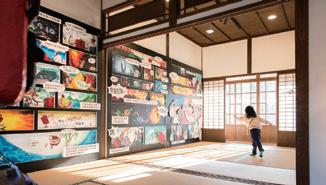
Great news for history buffs and comic aficionados. Taichung’s National Taiwan Museum of Comics, opened at the end of last year, caters to the interests of both. The museum resides within wooden structures dating back to the Japanese colonial era (1895~1945), originally utilized as dormitories for Taichung Prison guards and their families, situated adjacent to the site of the prison (demolished in 1992). The historically significant buildings also neighbor another noteworthy attraction, the Natural Way Six Arts Cultural Center. This Japanese-built dojo complex was formerly utilized to train law enforcement officials in martial arts. Within the restored dormitory buildings, visitors can explore displays featuring a large number of vintage comic and manga books, along with related artifacts and memorabilia. During the evening, the expansive complex has a particularly enchanting charm, enhanced by lights that beautifully illuminate its architectural features, making it an ideal setting for taking photos.

Amidst Taipei City's urban concrete jungle, you'll discover a surprising number of old, one-story wooden houses from the Japanese era. These resilient structures have withstood both modernization and the city's hot, humid climate. Many have been renovated and repurposed. One fine example is a cluster of houses on a lane branching off Jinshan S. Rd., located just to the north of National Taiwan Normal University. The buildings underwent restoration in recent years, a collaborative project between the Forestry and Nature Conversation Agency and the private-sector CMP Group. Formerly serving as dormitories for the Government-General of Taiwan’s Mountain Forest Section, the buildings stand in the shade of ten trees planted by their early inhabitants. They now house the 0km Mountain Center. Conceived as a nature oasis within the urban landscape, the center has a garden adorned with an impressive array of plants native to Taiwan. Additionally, it features a small exhibition space, a café, and a souvenir shop, all with a focus on forests and the natural environment. www.0km.com.tw
Over the past 13 years, tourism in Taiwan has been promoted by the Taiwan Tourism Administration (until recently known as the Taiwan Tourism Bureau) under the slogan Taiwan – The Heart of Asia . Prior to that it was Taiwan – Touch Your Heart . The latter was part of the first endeavor to establish a distinctive tourism brand for Taiwan, launched in 2001.
This May, a new slogan was unveiled to lead the tourism promotion efforts for this island in the foreseeable future. Departing from the “heart”-themed motifs of the past, the new slogan Taiwan – Waves of Wonders was selected, offering a fresh perspective and a captivating invitation to explore the myriad wonders of this easy-toreach getaway destination.
Drawing inspiration from the ocean surrounding this island, its vast mountainous terrain, and its extensive road and railway network of transportation arteries, the new motto encapsulates Taiwan as a travel destination brimming with an abundance of delightful surprises at every turn and aligns with the Tourism Administration’s marketing focus of Enjoy the Mountains, Embrace the Sea, and Explore the Island
To complement the imagery that is evoked by the slogan, a contemporary-style wavy font was chosen. The letters are rendered in a warm orange hue reminiscent of the sunrises observed along the island's eastern coast, adding to the visual allure of the overall design.
As part of the new brand launch, a promotional song written by well-known film score and commercial music composer Chris Hou, winner of Golden Melody, Golden Horse, and Golden Bell awards, and an animated short film were also released, enriching the campaign with appealing auditory and visual elements.
One of the key messages the administration aims to convey to international travelers in its forthcoming promotional initiatives is that Taiwan stands as a premier travel destination offering unparalleled quality and distinctive tourist experiences throughout the four seasons.
Following the global disruption of tourism caused by the pandemic and the endurance of several years of dwindling visitor numbers to Taiwan, the past year marked a notable resurgence, with 6.49 million visitors recorded. Given the current landscape in the international tourism market, which presents both challenges and opportunities, the Taiwan Tourism Administration is resolute in its commitment to intensifying promotional endeavors, aiming to surpass the 10 million visitor milestone once again swiftly.



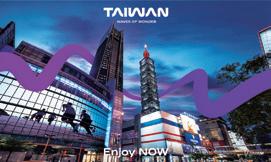
For more information about traveling in Taiwan, visit the Tourism Administration’s official website at eng.taiwan.net.tw



1
Musical
MAMMA MIA! THE MUSICAL
全本音樂劇《媽媽咪呀!》
August 28 ~ September 1
National Theater ( Taipei City )
Often described as a feel-good musical, Mamma Mia! premiered 25 years ago in London’s West End. Since then it has dazzled over 70 million people worldwide. In this whimsical tale, a young woman finds herself entangled in the chaos of planning her wedding, all while grappling with the mystery of her paternal lineage. Inviting the three men who could be her father to the idyllic Greek island where she lives with her mother, she unwittingly sets the stage for hilarious moments and confusion amidst the nuptial preparations. In addition to the story, the musical has been a big success for the timeless music masterpieces by Swedish pop group ABBA, one of which is entitled Mamma Mia npac-ntch.org
百老匯經典音樂劇《芝加哥》
July 24 ~ 28 National Kaohsiung Center for the Arts, Weiwuying ( Kaohsiung City )
July 31 ~ August 4 National Taichung Theater ( Taichung City )
August 7 ~ 11 Taipei Music Center ( Taipei City )
Chicago, a Broadway classic, first graced the stage in 1975 and held its audience spellbound until 1977, with an impressive run of 936 performances. It was revived in 1996 and has since become the longestrunning musical in Broadway history. The musical has also been performed for a record length of time in London’s West End, since 1997. Set against the backdrop of the glamorous 1920s, the work serves as a scintillating satire, weaving a tale of two incarcerated women who endeavor to secure their freedom by transforming themselves into media darlings, aided by the cunning machinations of a slick lawyer.
www.npac-ntt.org
CHEN CHI-KWAN: A DUET –ART AND ARCHITECTURE 陳其寬:雙曲.交響
Until September 22
Tainan Art Museum ( Tainan City )
Celebrating the life and artistic journey of Taiwanese artist and architect Chen Chi-kwan (1921~2007), this exhibition introduces visitors to his unparalleled achievements in both architecture and ink-wash painting. It also provides insights into his pioneering work in the modern architectural practice of hyperbolic paraboloid shells, which became trendy around the world in the 1950s. One of his most notable accomplishments was his collaboration with I. M. Pei in designing the iconic Luce Memorial Chapel on the Tunghai University campus in Taichung City, a hallmark of mid-century modernist architecture completed in 1963.
www.tfam.museum

Editor's Choice 5 6 4


Exhibition 4
50 YEARS OF PAINTING: WANG HUAIQING
王懷慶:五十年創作精選展
Until October 13
Asia University Museum of Modern Art ( Taichung City )
This exhibition showcases the evolution of Chinese artist Wang Huaiqing’s (b. 1944) creative work since the 1970s. Trained in Beijing during the Cultural Revolution, he transitioned from realism to landscape painting and later explored Ming-style furniture as a source of inspiration. He’s also known for fusing ink and oil painting, incorporating calligraphic aesthetics. His series Han Xizai’s Night Revel and Chinese Emperor are fine examples of blending traditional ideas with his philosophy. Wang has also innovatively magnified calligraphic strokes to create highly abstract compositions. This exhibition at the Asia University Museum of Modern Art features nearly 50 of the artist’s paintings and sculptural works. asiamodern.asia.edu.tw
Exhibition 5
TEAMLAB FUTURE PARK
teamLab共創!未來園
Until October 13
National Taiwan Science Education Center ( Taipei City )
teamLab Future Park is an innovative educational project centered around the idea of collaborative creation. It serves as a dynamic playground where kids can immerse themselves in the joy of shaping and crafting the world alongside others, fostering a spirit of creativity and exploration. Within its highly interactive and captivating spaces, children embark on a wondrous tour through a kaleidoscopic realm brimming with boundless imagination, encouraging them to explore, dream, and create freely. Part of the fun is drawing images of creatures and witnessing these images (after being scanned) come to life on giant touch screens. www.ntsec.gov.tw; futurepark.teamlab.art/en
Exhibition 6
LEONARDO DA VINCI –
500 YEARS OF GENIUS
達文西體驗展-超越 500 年的輝煌展
Until September 29
Songshan Cultural and Creative Park ( Taipei City )
This exhibition is a mesmerizing journey through the life and work of the legendary Italian polymath Leonardo da Vinci (1452~1519). Visitors delve into da Vinci's world of art, invention, and boundless curiosity in an immersive digital environment that blurs the lines between art and reality, virtually transporting you to the streets of Renaissance Italy. Central to the experience is meticulously crafted machine inventions, showcasing da Vinci's visionary genius. In addition, the groundbreaking work of French engineer Pascal Cotte unveils hidden details of the Mona Lisa, offering a unique perspective on this timeless masterpiece. www.songshanculturalpark.org

TEXT AMI BARNES PHOTOS RAY CHANG, VISION
The largest of Hsinchu County’s administrative districts by area, mountainous Jianshi Township is also its most sparsely populated. Humble homestays and wild walks can be found hidden among its vast expanse of densely forested slopes – perfect for world-weary travelers looking to break free of city confines.

At the confluence of the Naluo and Jiale rivers stands a huge weatherworn boulder. It is one of the first sights to greet travelers after entering Jianshi Township from the west. Strong, immovable, unyielding in the face of nature’s challenges, the Atayal tribesfolk – who still comprise the majority of Jianshi’s population – admired the rock’s indomitable spirit so much that they named their home in its honor. The name continues in Chinese – “jianshi ” means “sharp rock.” These days the township’s inhabitants occupy small pockets of livable land where they mostly engage in agriculture (peaches and bamboo shoots are the region’s primary crops), or tourism. Visitors, meanwhile, are drawn to the territory’s ruggedly pretty terrain, tribal villages, clear waterfalls, and forests that are home to millennial tree giants.

The village of Smangus ( smangus.org ; Chinese), which, depending on where you get your information, may have been named after a type of oak that grows abundantly in the area or after the leader who established the settlement, has gone by several nicknames over the years. Outsiders labeled it the “Dark Village” and the most remote tribal settlement in Taiwan, referencing the fact that it had neither mains electricity nor a road connection to the world until 1979 and 1995, respectively. However, the 170-odd Atayal villagers who call it home prefer the more salubrious epithet of “God’s Tribal Village.”
Many sources credit the 1991 “discovery” of a giant cypress tree grove for transforming the village from a farming hamlet into a sightseeing spot. In truth, the trees, which are huddled together in a sheltered stream valley, sit along one of the villagers’ old hunting routes, so perhaps calling it a rediscovery or reconceptualization of their value is more accurate. Either way, before that, Smangus had been facing the same sad decline as other remote rural communities throughout Taiwan – a lack of job opportunities and the hardships of rural living had drained the population
of its youth. But, to butcher a proverb, when life gives you remoteness and nature, why not make an eco-tourism tonic for the city-bound masses? News of the ancient trees’ existence spread, more people began visiting, and this planted the seeds of Smangus’s rebirth as an eco-travel destination.
The process was not without growing pains though. Competition supplanted the more collaborative way of life that Atayal communities traditionally adhered to. Neighbors began fighting to entice customers to their homestays and restaurants, and – dismayed by these squabbles – tribal council members proposed the radical solution of running the village as a cooperative enterprise. After all, if group efforts had filled the villagers’ bellies for centuries, surely that philosophy could be made to fit the modern world –the tribal unit’s communality and hospitality superseding hunters’ stamina and cunning as essential skills du jour.
Nearly a quarter of a century into the experiment, its success is reaping dividends. Around 80% of the residents have opted into the program, receiving a monthly stipend and benefits in return for working a rotating roster of yearround and seasonal tasks. The result is something unique


among the indigenous communities-turned-tourist attractions that I’ve visited in Taiwan. There is no performative indigenousness on display here, and travelers who go seeking such may come away disappointed. Instead, you’ll encounter locals just going about their daily work, and it feels like you’ve been welcomed into an indigenous family-run B&B that has been scaled up to the size of a village.
Given its remoteness, getting to Smangus is still something of a mission. There’s no public transport, and the drive, which follows County Highway 120, then Township Road 60, and then a winding concrete track that’s barely worthy of being called a road, takes a good couple of hours from Hsinchu City. The somewhat arduous nature of this journey means that many visitors prefer to hire a driver, and most choose to make the trip worthwhile by spending the night in the village. Room rates vary from around NT$1,500 for a midweek twin room outside peak periods, to NT$6,000 for a double with valley views during the February-March cherry blossom season. Reservations can be made by telephone (03-584-7688), and if you plan to eat at the village’s sole restaurant, you’ll need to prebook your meals (same telephone number). It’s also worth pointing out that, in line with the waste-reduction principles of eco-tourism, guests are asked to bring their own toiletries (only towels are provided).





Aside from the village itself, the Giant Tree Trail is the number one draw for visitors to Smangus. The trail takes 4~5 hours and consists of a roughly 5km walk out, followed by a 1km loop through the giant tree grove, and return the same way. In total, you’ll cover a little under 500m of elevation gain, and while there’s some moderate exposure to heights, walkers are never at any risk of a fall. The path underfoot is mostly compacted earth or loose gravel, there are no turnoffs or unclear sections to navigate, and rest areas and bathrooms can be found along the way.
The above details mean the trail is generally considered easy, but, as with all wilderness pursuits in Taiwan, an outing still demands careful preparation. The weather in mountainous regions can change on a dime, especially during the thunder-prone summer storm season, so check and double-check the weather forecast before setting off. Similarly, due to the elevation (1,500~1,600m above sea level), you can expect the air to be considerably cooler than in lowland areas. The trailhead is located right beside the village’s small general store, so you can stock up before setting off – at a minimum, you’ll want a bottle of water and a snack to keep up your energy levels.
Almost from the moment you leave the paved road, you’ll find yourself embraced by a towering forest of makino bamboo. The culms – each as fat as a coke can – stand tall and straight, upper leaves animated by wind so that they ripple like waves on a restless sea. Bamboo forests have a special type of aliveness. They’re never quiet, always creaking or whispering or groaning. And if you stop to listen on a dry day, even critters as tiny as a spider can clearly announce their presence by clambering over the carpet of papery fallen leaves.
As the bamboo gives way to a more mixed forest, you’ll find yourself crossing a handful of leafy creeks. Foliage beside the trail hides the remnants of an old mushroomdrying hut – a relic from the pre-tourism era, when growing shiitake mushrooms and peaches was the village’s main income source. Further along, a young cherry orchard has been trained into a pretty tunnel, and not far beyond this is a stand of Japanese cedars that were planted to provide trailmaintenance materials.
When the sound of running water begins encroaching at the edges of your consciousness, you’ll know that you’re getting close to the giants. The trees have all gathered within a stream valley, the cool waters of which were previously used by hunters to chill freshly caught game. A recently built wooden walkway leads through the giants’ forest kingdom, and 35 of the grandest trees have signs bearing their Atayal nickname as well as information about their species, age, height, and circumference. A 45m-tall Formosan cypress named Yaya is the largest, having spent two-and-a-half
millennia growing strong, healthy, and sky-high, her roots headed the other direction and sunk deep in the fertile earth. She is a particularly characterful specimen – with limbs that resemble arms raised in wild gesticulation as if she has been frozen mid-remonstration with the wind.
The Travel in Taiwan crew were the last walkers on the trail on the day we visited and, with no one else around, our tardiness gifted us sightings of muntjacs, striped squirrels, and a seemingly fearless Swinhoe’s pheasant. Powered by the excitement of these sightings and thoughts of food, our return journey passed swiftly and, before long, we were enjoying dinner in the village’s restaurant overlooking the deep river valley in which Smangus resides, the village perched high up its north slope.

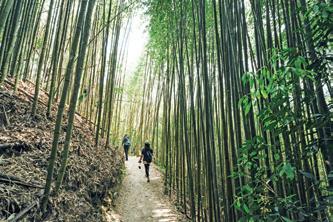
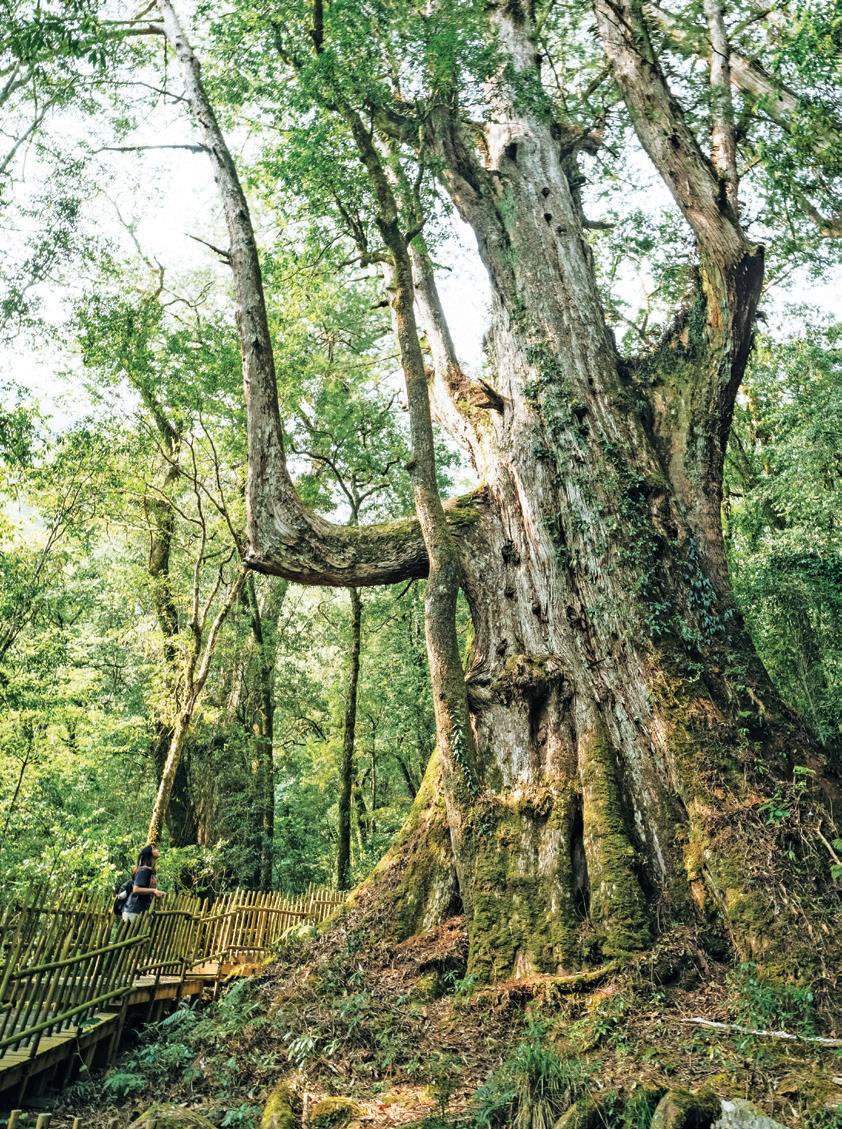

The Giant Tree Trail may be the village’s longest and bestknown walk – indeed, it is so beloved by local hikers that it has been voted one of the top 100 trails in Taiwan. However, it’s far from the only option for visitors wishing to explore the area on foot. Maps displayed around the village show a total of seven trails, ranging from 30min short jaunts to 3km walks, most of which require no more equipment than a bottle of water and some comfortable shoes.
If you visit during the rain-drenched summer months, it would be well worth including a slight detour to the 20m Silifu Waterfall on your trip to see the giant trees. The route adds an extra couple of kilometers onto the walk and involves a bit of a steep descent (and return ascent). But since we went after a dry spell, we decided to skip this and visit a couple of shorter trails on the village’s western fringe instead.



Starting from the visitor center and check-in desk, we followed signs directing us up a lane towards Koraw Eco-Park Trail and towards a viewing platform. As we walked, we found ourselves passing the village’s red-roofed church, then a jerry-rigged pigeon coop. Continuing up, we encountered a pair of cows that swished their tails and eyed us impassively, hard at work producing top-notch organic fertilizer for the village’s crops. After a 10min sweetgum-shaded climb, our feet were kicking up little puffs of dust on a short sandy ridge leading to a wooden observation deck. The platform, which marks the top of the steep Hunter’s Trail , affords hikers a clear line of sight back towards the village. Buildings dot the bamboo-cloaked near slopes, while layer upon layer of origami-like ridges and peaks fill the background. In early spring, this already spectacular scene is transformed into a picture-perfect postcard view as the cherry trees put on a spectacular display of pinks.
Since the viewing platform is the highlight of the Hunter’s Trail, we didn’t pursue that path any further and instead retraced our steps until we found ourselves at the start of the Koraw Eco-Park Trail. This lollipop loop passes through the villagers’ old millet-growing grounds. The millet plots are long gone, and the area has been returned to the gentle stewardship of nature. The trail is an easy-to-follow 1.5km shady stroll along unpaved paths that are cushioned with the leaves of beeches and oaks. And, at one point along the walk, there’s also a rope swing that demands to be swung upon. (Did I oblige, you ask? Of course, I did.)
The forest here is known to provide homes and sustenance for a diverse array of wildlife. Intrepid nighttime visitors might glimpse either of the two varieties of flying squirrel that are found in Taiwan, or hear the hoot-hooting of a mountain scops owl. During daylight hours, it’s possible to see deer, squirrels, toads, and an impressive number of birds. In fact, Smangus is a joy for bird watchers. Endemic species and subspecies abound, and you barely need to step off the roads to get spotting. Before the hour hand had reached eight on the second morning of our visit, I had already clocked numerous Taiwan yuhinas, white-eared sibias, a Steere’s liocichla, a green-backed tit, and (a personal lifer) a rusty laughingthrush.



Roughly 8km from Smangus as the crow flies, there’s a second, even grander group of arboreal giants. The cluster is known as the Zhenxibao (or Cinsbu) Sacred Tree Grove, and getting to it involves an even rougher ride than the journey up to Smangus. Fortunately, the route can be broken up with quick stops at a couple of points along the way.
Following Township Road 60 to its southern end will bring you to Xinguang village, where you’ll find a basic convenience store and a preponderance of indigenous homestays offering an alternative to spending the night in Smangus. Another kilometer beyond the village is the option of a brief detour to Zhenxibao Presbyterian Church. The entire exterior of this nearly 80-yearold building is clad in a mosaic of green and white stones – green sourced from the nearby Xiuluan River, while the white is marble recycled from an abandoned house in Hualien. Atayal folkloric characters and motifs are depicted in the stone, and painted on one wall is a mural showing the Christian loaves and fishes parable with characters attired in traditional tribal clothing. All the familiar hallmarks of Christian worship are present – the lectern, the pews, the cross on the roof – but they are colored with a uniquely indigenous Taiwanese flavor.
About 25 bumpy minutes from the church saw us arriving at the middle-of-nowhere trailhead of the Zhenxibao Sacred Tree Trail , and with suncream slathered and snacks packed, we wasted no time setting off. The first 30min were gentle, but then we dipped to cross a stream and the difficulty level picked up a gear from there. At just over 8km, this route is shorter than the Smangus Giant Tree Trail and has a similar amount of elevation gain, but the steeper climbs meant it ended up taking us a full 5 hours.
Luckily, there’s more than enough beauty to assuage any tiredness. Carpets of mosses and occasional wildflowers paint the understory while bird’s nest ferns sporting fresh fiddlehead coronets pack the trees, and upon reaching the grove of Taiwan red cypresses, it became clear that the forest had been holding back its best to share with those willing to put in the legwork. As at Smangus, the trees had gravitated towards an area threaded with streams, the presence of water lifting my mood as it tempered the creeping heat and scented the air with a sweet blush of moist, loamy soil. At one point, a patch of forest floor wriggled loose in a quiet explosion of rustling, revealing itself to be a mountain keelback – a non-venomous snake species that extends its hood, hoping you’ll be fooled into believing it’s a big, scary cobra.
The 2km loop through sacred giants took us two hours, much of which was spent with heads uptilted since many trees that hadn’t been officially designated as “giant” towered above us. I can’t help but feel the tools I have for comprehending such lifeforms are woefully inadequate. My initial instinct is to create distance to take in the full scale. But the trees themselves seem to call you closer – as if they know laying hands on their rough, whorling bark and observing the myriad minute and life-filled universes that have taken root in each crevice offers a better way to know the truth of them. But no matter how hard I try, my mind slides back and forth between the micro and the macro, unable to grasp both at once.
On reflection, perhaps I am trying too hard. That these giants quietly continue to exist, ever-ready to welcome us into their mountain abodes, perhaps that itself is enough.



A trip to Smangus and the Zhenxibao sacred trees takes the better part of two days. However, if you’ve already committed to the drive, it seems a shame not to make the most of it – especially since there are more than enough pleasant diversions scattered along Township Road 60 to fill an extended long weekend.
Not far from Neiwan – an old mining town that is worthy of a halfday trip in its own right – the road passes the Frog Rock Foot Path. This easy 2km out-and-back boardwalk follows the course of a waterway as it makes its way to a glass-floored viewing platform overlooking a frogshaped boulder. Atayal legend tells that long ago, frogs and mosquitos were sworn enemies (as someone who is well acquainted with the local bloodsuckers, I fully support the frog in this matter). One day, a frog chased a swarm of mosquitos into the river valley here, devouring them one by one until just a single mosquito remained. The frog pursued that final survivor upstream as far as a waterfall, where the mosquito – able to fly above the cascade – slipped away. The poor frog couldn’t go any further. Thwarted, it stopped in its tracks and just stared longingly after its quarry until it eventually turned to stone.
Access to the trail is ticketed (full price is NT$100), and both tickets and parking are found 1.2km up the road beside a FamilyMart convenience store and a farmers’ market. A shuttle-bus service running between the farmers’ market and the trailhead is included in the ticket price, making the walk an ideal half-day adventure for families with kids or individuals who favor shorter, flatter trails.
Half an hour’s worth of driving further inland and uphill will bring you to the Yulao Lookout . This mountain pass, which is a popular destination with pedal and petrol-powered bikers alike, offers big-sky views and a place to grab a quick snack. From beside the adjacent police station, you can look back and westwards over the landscape you’ve just climbed. In the other direction, sharp-eyed observers gazing east in clear weather might be rewarded with a glimpse of Mt. Dabajian (of NT$500 note fame). A smattering of stores cater to the weekend cycling crowd, but parking options are few and far between.






From the lookout, the road snakes down to Xiuluan , a riverside hot-spring village with a couple of suspension bridges strung across the river valley as well as a few hot-spring hotels. Hot water used to bubble up in large quantities from the riverbed here, but heavy rains have changed the landscape, and now the closest au naturel spring is Taigang Wild Hot Spring – an hour or two of river tracing upstream in the dry winter season.

ENGLISH AND CHINESE
Atayal | 泰雅族
"Dark Village" | 黑暗部落
Frog Rock Foot Path | 青蛙石天空步道
Giant Tree Trail | 巨木群步道
"God's Tribal Village" | 上帝的部落
Jiale River | 嘉樂溪
Jianshi Township | 尖石鄉
Hunter’s Trail | 獵人步道
Koraw Eco-Park Trail | Koraw 生態公園步道
Mt. Dabajian | 大霸尖山
Naluo River | 那羅溪
Neiwan | 內灣
Silifu Waterfall | 司立富瀑布
Smangus | 司馬庫斯
Taigang Wild Hot Spring | 泰崗野溪溫泉
Xinguang | 新光
Xiuluan (River) | 秀巒 ( 溪 )
Yulao Lookout | 宇老景觀台
Zhenxibao Presbyterian Church | 鎮西堡長老教會
Zhenxibao Sacred Tree Grove | 鎮西堡神木群
Zhenxibao Sacred Tree Trail | 鎮西堡神木步道
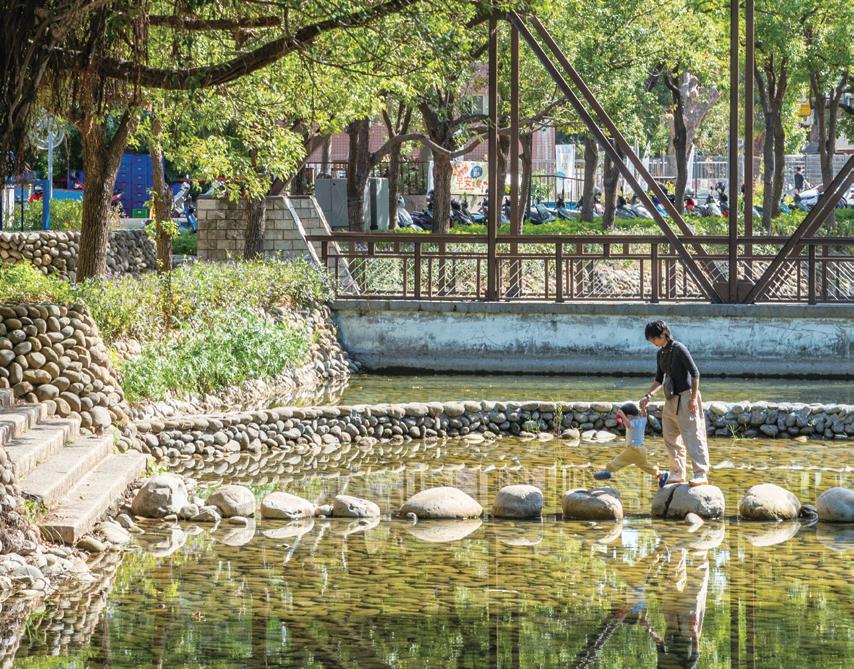
HWith easy rail and road connections, the northwestern coastal municipality of Hsinchu is a convenient day-trippable distance from Taipei. Visitors can spend a pleasant morning strolling its streets hunting for history, an afternoon cycling towards sunset, and an evening attending to both spiritual and bodily needs with a visit to a marketensconced temple.
sinchu is a city that has wholeheartedly embraced modernity. Homegrown international tech companies have turned its sprawling, 1,400ha science park into a technology hub of global importance, while the city’s many universities have given it an injection of youth culture and a bounty of inexpensive eateries. Standing in stark contrast to this modern image are the various living traces of the city’s deep history as well as easily accessible natural spaces like the scenic 17km Coastal Bikeway. When taken together, these elements form a strong foundation for a rewarding and multifaceted day out.

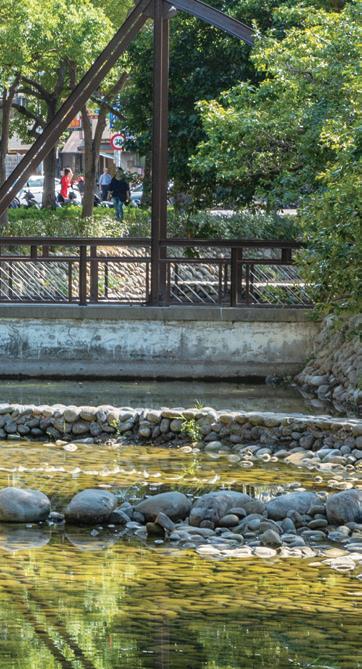
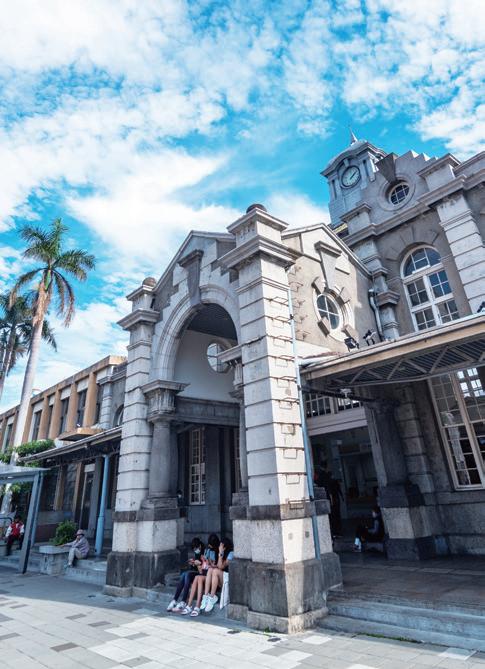
Just over an hour by Express train from Taipei (90min. by local train), Hsinchu Railway Station is the ideal jumping-off point for a foray into this oft-overlooked and underappreciated city. The station, which celebrated its centenary in 2013, is Taiwan’s oldest surviving station building still in use. It was designed by Matsugasaki Tsumunaga, a German-trained Japanese architect whose Baroque-infused flourishes added a touch of European style to structures throughout Taiwan. Most of his creations have been lost to time and modernization, and today the iconic The Red House in Taipei’s Ximending district (co-designed with a second Japanese architect) and this station are all that remain.
Turning left out of the station, a 200m wander west along Linsen Road brings you to the southern end of Hucheng He
Riverside Park . This oasis of water and greenery threads its way through the heart of present-day Hsinchu City, tracing the course of the moat that once encircled the city walls. Nestled among the foliage are other remnants of historic fortifications, like the support columns for two bridges and the old East Gate (Yingxi Gate). The almost 200-year-old gate has been given monument treatment and now sits proudly on the edge of a pedestrianized plaza that can only be entered via subterranean walkways. Mirrors line the walls on one side of these tunnels, reflecting the historic stonework and brickwork left exposed, and – when school’s out – provide Hsinchu’s youth with space for practicing their dance moves.


Ever since Hsinchu became a fortified city in the 1730s, Hsinchu Chenghuang Temple (or Hsinchu City God Temple) has occupied space at its core. City God temples exist throughout Taiwan as a spiritual foil to city-level politics. Their main deity is always Cheng Huang Ye (aka the City God) – a Taoist figure whose role in the supernatural realm is akin to that of a modern-day mayor. Time has slackened such temples’ connection to politics, but they nevertheless are sustained by legions of dutiful devotees.
Over the decades, a profusion of vendors selling fried, grilled, skewered, and candied snacks has been drawn in by the inescapable magnetism that such vital religious centers seem to possess. Surrounded by these businesses, the only hints of this temple’s existence on approach are its brightly colored roofs rising above the stalls and a couple of narrow archways leading into the market/temple labyrinth interior.


Ducking through one of the entrances is like entering a self-contained parallel world. Vendors weave through the crowds with the sure-footed nimbleness of alley cats as they bear bowls of steaming noodles aloft to hungry diners, and clouds of enticingly-scented vapor waft along in their wake, mingling with the heady aroma of incense smoke billowing from the censer in the table-lined temple courtyard.
If you were hoping for calm upon stepping into the temple itself, you would be left wanting. The inside is as colorful as an explosion in a paint factory and chock-full of deities jostling for altar space. As well as the City God himself, you’ll find Taoist and Buddhist figures – Guanyin (Goddess of Mercy), the Maitreya Buddha (rotund and jovial), Yue Lao (spiritual matchmaker, aka “Old Man under the Moon”), the City God’s wife (fixer of marital issues), and plenty more. Even when Travel in Taiwan visited the temple for this article
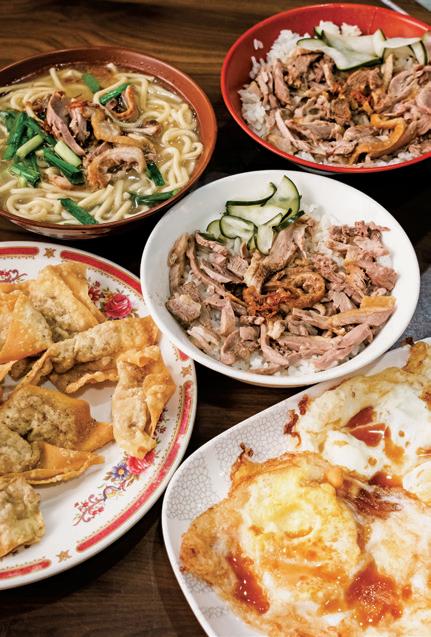
on a Monday morning, the walkways were packed with incensetoting believers seeking favor and guidance.
After the excitement of the temple, it’s well worth exploring the area’s other many and varied eateries. Hoping to narrow down our selection, we picked a couple of spots most popular with local foodies. First up was Lin Family Taro Balls. This vendor sells just two items – the original taro-only version and one with melted mozzarella. Each ball is a huge nugget of doughy, deep-fried, and lightly sweetened taro mash, and be warned – they’re filling. One is definitely enough to split between two if you’re trying this snack treat out of curiosity.
Another regular feature of guides bringing people to the temple market and surrounds is Miaokou Duck Rice. Top billing on the menu goes to the dish that gave the store its name – bowls of sticky white rice loaded with tender umami cuts of duck and slivers of sweet-sharp pickles. Accompanied by a soy sauce-
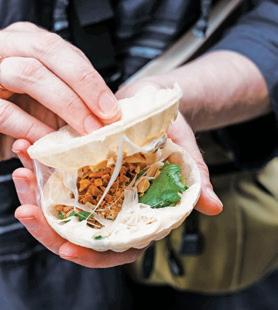

slathered egg and deep-fried wontons, and washed down with a bowl of pork balls in broth, this is a fulsome meal, but it would be a shame not to leave a little room for dessert.
One sweet option that won’t leave you feeling overstuffed is Guihong Fuling Cake. The confections of this vendor have a similar flavor profile to the Taiwanese ice-cream burrito. Chopped peanuts and cilantro sit on a chewy bed of white maltose taffy, all of which is encased in a crispy biscuit shell. The flavors sound unorthodox to a Western palette, but this roadsidestall operation has been in business for over six decades, so it certainly has the locals’ seal of approval.
If after this your sweet tooth remains unsated, head to the nearby Pinxin Ice Shop. A comparative newcomer to the area, Pinxin sells mounds of fruit atop hillocks of shaved ice – the perfect defense against summer’s inescapable heat.
Stretching from Zhunan Coastal Natural Park (in Miaoli County) in the south to Nanliao Fishing Harbor (Hsinchu City) in the north is the flat 17km Coastal Bikeway that hugs the coast for, yes, a full 17 kilometers. Undertaken purely on two wheels, the ride can fill the better part of a day, especially when factoring in breaks for exploration and refueling. However, if you’re seeking briefer alternatives, then either driving or catching a local train to Xiangshan Railway Station and picking up a YouBike rental bike at the station would allow you to condense the trip into a single afternoon.
Not only is Xiangshan Railway Station a good jumping-off point for your ride along the Hsinchu coast, but it’s also a noteworthy destination in its own right. The original station was built in 1902, although the current building dates to a later 1928 expansion and makeover. At the time, the Japanese authorities governing Taiwan were in the midst of a massive drive to expand rail and road infrastructure, primarily to transport commodities from the south and interior to ports along the coast, where they could be loaded onto ships bound for Japan. Like many other Japanese-built structures from that era, it was constructed using local hinoki, a type of wood sourced from Taiwanese red cypress trees that’s highly prized for its durability, pleasant fragrance, and beautifully warm tones. Even if you don’t have a train to catch, you can pop in to take a seat on the wooden benches lining the waiting room and meet the station master’s cat.
Heading northwards, the next port of call for us was the Xiangshan Wetlands . This vital wetland habitat, spanning nearly 17 square kilometers from the Hsinchu-Miaoli boundary to the Keya River, was once threatened by land reclamation projects. Thankfully, local environmentalists were successful in fighting for its preservation and now the dunes, mudflats, and mangroves provide a home for a diverse array of wildlife. The wetlands’ star attraction is undoubtedly the Crab Viewing Boardwalk . Here, visitors can observe numerous crab species as well as comical-looking mudskippers. Fiddler crabs dominate the higher reaches of the foreshore, the largest among them easily fending off smaller rivals with a warning wave of a lopsided pincer, while more evenly matched opponents dance dueling circles around their burrows. Out at the boardwalk’s seaward end, tiny soldier crabs hold sway, and in contrast to their less social neighbors, they march across the flats in small, coordinated troops. So numerous are the crustaceans here that –if you sit quietly on the edge of the boardwalk – you can hear the sound of them eating.
The final stop on our day’s journey was Nanliao Fishing Harbor This is right up at the northern end of the bikeway and is comprised of a working fishing harbor surrounded by the kind of amenities that have turned it into a destination popular with day-trippers and locals alike. A large grassland area – used each September as the venue for the Hsinchu City International Kite Festival – is often filled with families making use of Hsinchu’s legendarily windy conditions to practice flying their kites. Refreshments are covered in the form of a weekend market selling light bites and drinks, as well as a gathering of shipping containers that have found a second life as coffee and ice-cream stores. And as the shadows lengthen, what better way to round off the day than by joining the groups of friends and couples gathered on the Nanliao Fish Scale Steps to watch the sun plunge into the waters of the Taiwan Strait!











ENGLISH AND CHINESE
17km Coastal Bikeway | 17 公里海岸自行車道
Cheng Huang Ye | 城隍爺
Crab Viewing Boardwalk | 濕地賞蟹步道
East Gate | 竹塹城東門
Guihong Fuling Cake | 桂紅茯苓糕
Hsinchu Chenghuang Temple | 新竹都城隍廟
Hsinchu City International Kite Festival | 新竹市國際風箏節
Hsinchu Railway Station | 新竹火車站
Hucheng He Riverside Park | 護城河親水公園
Keya River | 客雅溪
Lin Family Taro Balls | 林家芋泥球
Miaokou Duck Rice | 廟口鴨香飯
Nanliao Fishing Harbor | 南寮漁港
Nanliao Fish Scale Steps | 南寮魚鱗天梯
Pinxin Ice Shop | 品馨冰菓室
The Red House | 紅樓
Xiangshan Railway Station | 香山車站
Xiangshan Wetlands | 香山溼地
Ximending | 西門町
Zhunan Coastal Natural Park | 竹南海濱自然公園


Hsinchu County in northwest Taiwan is beloved by tourists for the natural beauty of its hills and for the concentration of Hakka culture, with attractive small towns established centuries back today warmly welcoming visitors. The Hakka are a Han Chinese minority that form about 16% of Taiwan’s population. In China, for many centuries, they primarily inhabited upland areas, engaging in farming, mining, and logging. These traditions were continued by Hakka migrants after they arrived in Taiwan. Hsinchu County is almost all hills, until reaching the spine of mountains in the island’s center. The Hakka primarily live away from the coast, in the formerly remote upriver regions. Come visit the popular oldtime settlements of Beipu and Guanxi, and learn about three Hakka culinary icons.

Beipu and Guanxi are both located on curvaceously scenic Provincial Highway No. 3, woven through the western foothills from north to south in the era before today’s two west-side freeways were constructed. The highway was built to facilitate economic activity and ensure continued communication should the more exposed flatlands Highway No. 1 be cut in conflict with communist China.
Beipu – the word means “north flat land” – is set atop a richly fertile low plateau. In the smaller Nanpu or “south flat land” community next door, visitors can learn about traditional farming and experience the life of farmer folk. A slender, shallow valley of neatly sculpted rice paddies courses between. Beipu was long second only to the small city of Hsinchu as a county commercial nexus, and is today home to the densest concentration of Hakka cultural elements of any Hsinchu settlement. The Beipu Old Street area is thickly populated with heritage buildings.
Among the copious meaningful structures you’ll come across on a leisurely walkabout is the Jiang Family Ancestral Temple (built in 1924), one of Taiwan’s four key ancestral temples. The Jiang Ah Hsin Residence (1949; Jiang Ah Hsin was a wealthy black-tea merchant) is an imposing work of Baroquestyle architecture. Jin Guang Fu Hall (1835) was a pioneer-settlement office. Citian Temple (1846) was built by the responsible land development association – in one role to serve as a defensive fortification against the displaced local native peoples.
DIY leicha experiences are a big Hakka-culture tourism draw. Visit the Guangfu Teahouse , a rambling old wood-and-red-brick enterprise homey with Beipu antique and retro treasures. Leicha , or lei tea, crafted with a mortar and pestle, is not traditional tea, but a meal-like beverage made with dried tea leaf, roasted peanuts, sesame seeds, and pumpkin seeds. Such hearty fare is quintessential in traditional Hakka life, replenishing the body after strenuous manual labor.

Guanxi is at the head of a long, thin, very fertile valley that runs to the sea by coastal Hsinchu City. Behind it, further inland, are high hills that brought logging and mining wealth in the past. At its core is Guanxi Old Street , a short and narrow artery lined with heritage buildings. Along the north section are numerous twostory structures with Western Baroque-design façades, once the combined commercial/residential facilities of successful Hakka merchant families. The south section is dominated by vintage single-story brick shophouses (shop in front, family living quarters in back).
Two renowned local businesses a short walk from Guanxi Old Street are King Tai Tea and Ang Gu Noodles. King Tai Tea Company (www.kintaitea.com; Chinese) is a tea-processing operation, founded in 1936, that has a gift-and-souvenir retail outlet. Its specialties are Hakka-style aged fruit teas and teas created in ancient Tang and Song dynasty baking style, using charcoal and longyan wood. Chinese-language tours are available. Ang Gu Noodles (www.anggu.com.tw ; Chinese), founded in
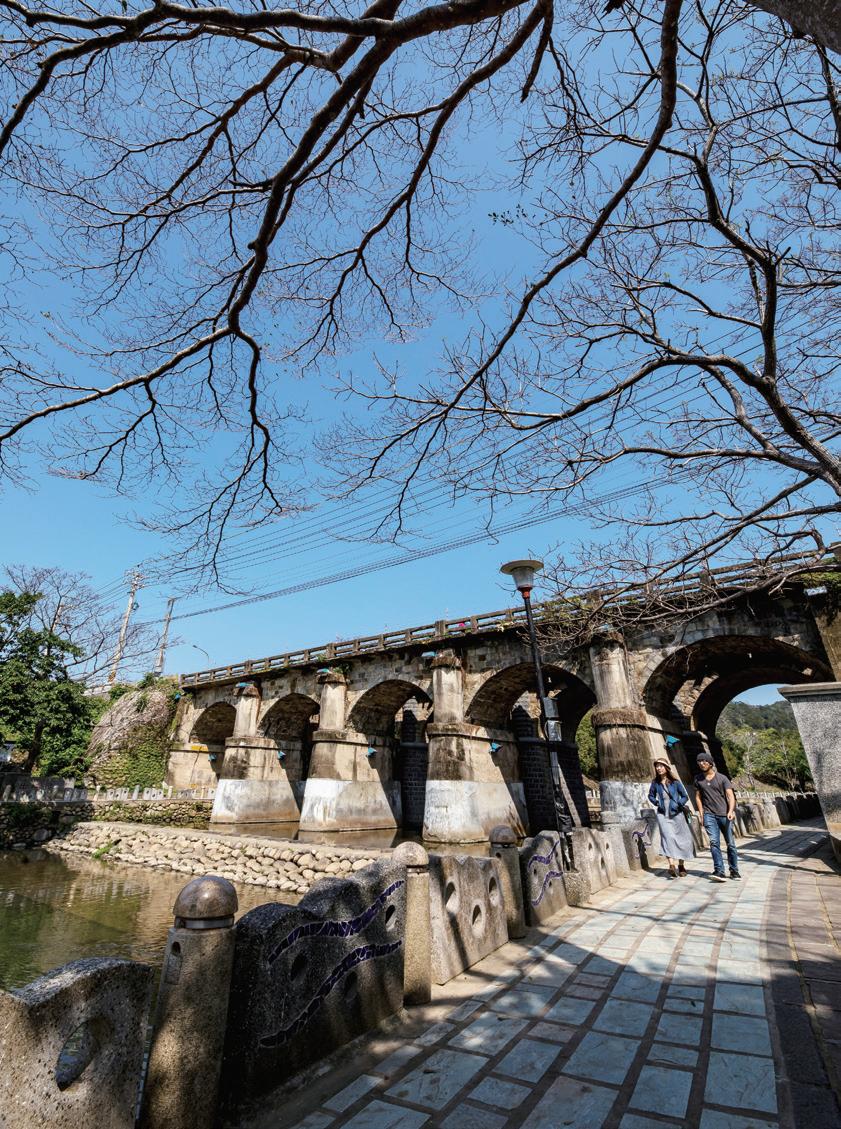
1955 and also family-run, specializes in faithful old-recipe dry-noodle dishes. Hottest from the menu are Hakka dry bantiao (a type of thick, broad noodle), “Ang Gu” dry wheat noodles, wonton noodles, and sesame-oil chicken.
The attractive, architecturally conspicuous Gothicdesign Guanxi Sacred Heart Catholic Church was built 1955~1956. The local parish was established in 1954 by Canadian missionaries, who learned Hakka to more effectively proselytize. The church interior and exterior have been shoot locations for several popular Taiwan TV drama series, making it a top Guanxi daytripper checklist stop.
The handsome Dong’an Bridge spans the narrow river that flows out of the mountains through the village. This stone-arch work of art was built by the Japanese – colonial rulers of Taiwan 1895~1945 – to replace a Japanese woodbuilt bridge dangerously weakened by Taiwan’s powerful rain, humidity, typhoon, and earthquake quartet. The heavy-duty bridge greatly facilitated the conveyance of timber and other resources down from the high hills.
Hsinchu County’s rural residents take advantage of seasonal winds to produce wind-dried foods from September through December. Look at Taiwan using Google Maps and you’ll see how the county juts out into the Taiwan Strait compared to the island’s areas further north. Local winddried specialties include rice noodles and dried persimmons. Sometimes translated as rice vermicelli, the thin rice noodles called mifen were brought to Taiwan by Han Chinese pioneers from Fujian (most Hakka came from coastal Guangdong, to the south). Hsinchu’s mifen is slightly thicker than the norm. Stir-fried mifen is the standard, Hakka folk especially like to eat it at breakfast, and a Hakka variation is to add chunks of pumpkin.
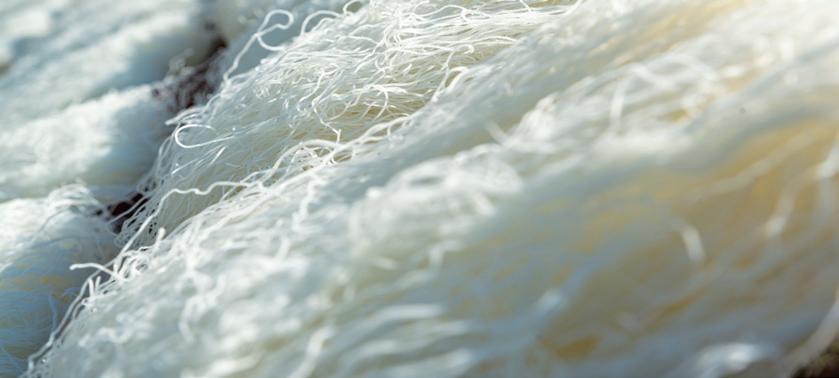
Preparing aged fruit tea – aging tea leaf in citrus shells – is an age-old Hakka tradition. The classic Hsinchu practice is to place processed springharvest leaves in autumn-harvest pomelo. The large citrus is hollowed, the fruit pulp is mixed with the leaves, and the mixture is packed inside and sealed. The shell is then steamed, pressed, sun-dried, and baked, then stored for years to age. The tightly string-wrapped shells turn dark, almost black, and take on the appearance of a small gift package. When ready, the fruit is split open with a hammer. The extremely aromatic brew that results is believed to aid in digestion, the beneficial medicinal qualities said to increase in potency the longer the aging.
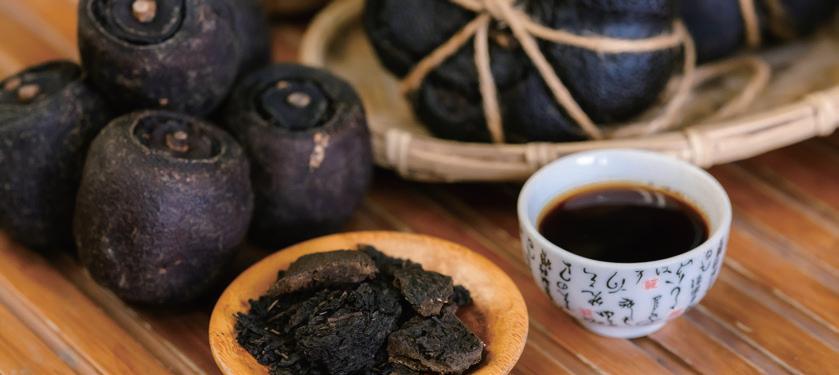
Taiwan’s native persimmons taste bitter and have a hard texture. The traditional method for the creation of fragrant, sweet, meatily chewy dried persimmons is a time-consuming process. Persimmons are picked that are about 80% ripe, the calyx and skin are removed by hand, and the fruits are placed in a sauna-like oven for smoking, curing, and hardening. They are then set out for wind and sun exposure in wide pans placed atop bamboo racks for three or four days. The softened result is then compressed. Xinpu Township, to the west/northwest of Guanxi, produces fully 80% of Taiwan’s dried persimmons.
English and Chinese
Ang Gu Noodles ㄤ咕麵
bantiao 粄條
Beipu (Old Street) 北埔(老街)
Citian Temple 慈天宮
Dong’an Bridge 東安古橋
Dried persimmons 柿餅
Guangfu Teahouse 廣福茶坊
Guanxi (Old Street) 關西(老街)
Guanxi Sacred Heart Catholic Church 關西天主堂

Jiang Ah Hsin Residence 姜阿新洋樓
Jin Guang Fu Hall 金廣福公館
Hakka 客家
King Tai Tea Company 錦泰觀光茶廠
leicha 擂茶
mifen 米粉
Nanpu 南埔
Xinpu Township 新埔鎮

The area around Taipei’s underground MRT Zhongshan Station is today a shopping and leisure hotspot, especially with local young fun-seekers and international tourists, drawing the crowds with glitzy large retailers, scores of cultural-creative shops, and a unique “linear park” dotted with iconoclastic public artworks that flows through the neighborhood’s heart.
This metro station is located in what is known as West Taipei (comprised of Wanhua and Datong, the city’s oldest districts), under the intersection of Nanjing West Road and the Xinzhongshan Linear Park. West Taipei’s fortunes ebbed for decades during the last century when the most progressive economic activity shifted to the city’s east, but the Taipei Metro system’s advent in the 1990s along with systematic urban-regeneration initiatives over the past two-plus decades led by the city government have brought a renaissance, especially around the major metro stations.
On a day-tour exploration of this area, entertainment is also to be enjoyed “in” the station itself, for the long underground Zhongshan Metro Mall runs right through the concourse level. This was the first underground mall built in Taipei; it stretches from Taipei Main Station to Shuanglian Station.
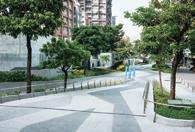
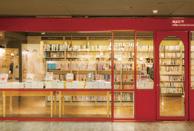


The swank Eslite Spectrum Nanxi (meet. eslite.com) is right on the Nanjing W. Road/linear park intersection. Debonair Shin Kong Mitsukoshi department store buildings are right beside and right across. “Eslite Spectrum” is a leading brand name in Taiwan cultured living, each complex built around a posh-design Eslite Bookstore anchor. Within the multi-level Spectrum Nanxi complex are more than 100 Taiwanese brands, such as Mao’s Studio, DengYi, and BUWU.
This green corridor travels directly above the underground mall. The rhythms of the seasons are echoed along its extent with the cultivation of significant plant diversity; and while traversing it you’ll also pass a steady stream of artworks, many whimsical. The park, especially around the metro station intersection, has become a social hotspot, with large retailers concentrated around the intersection; a legion of characterful cafés, eateries, cultural-creative shops, and studios is set up in the vintage buildings, including several meaningful heritage structures, along the park’s sides. At night the park transforms into a “moonlight forest,” aglow with mood lighting, with two key selfie spots a tall people-watching staircase platform overlooking the Nanjing/park intersection and, not far away, a pedestrian bridge becoming a coruscating 3D tunnel of starlight.

Next, head out into the labyrinth of streets, lanes, and alleys surrounding the Nanjing/linear park intersection to see how the neighborhood is shaping up, with visits to cultural-creative endeavors. Begin with the Museum of Contemporary Art Taipei (MOCA Taipei; www.mocataipei.org.tw), another key anchor of this neighborhood’s rejuvenation, opened in 2001 as the first museum in Taiwan dedicated exclusively to contemporary art.
Its home is an important protected heritage building constructed by the Japanese in 1921 to house the Jian Cheng Elementary School (primarily Japanese students). After Japan’s WWII defeat and the Republic of China takeover, it long hosted the Taipei City Government (1945~1994). The twostory red-brick structure is a model of architectural symmetry. The architectural style is a hybrid of Victorian and Edwardian elements, with perhaps the most visually compelling attraction being the bell tower rising from the roof’s center. MOCA Taipei, which has no permanent exhibits, focuses on the themes of art, design, and architecture.

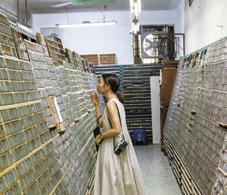


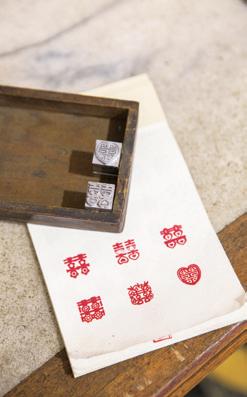
Hidden inconspicuously away down a narrow alleyway along which the slim shopfronts look as though they were frozen in time in Taiwan’s 1960s, family-run Ri Xing Type Foundry (www.letterpress.org. tw; Chinese) is Taiwan’s sole remaining type foundry. In times past this enterprise played an indispensable role in the field of letterpress printing using movable type; it was established in 1969, just before the local industry began to wane. Ri Xing was left standing alone in 2005 when the last two other Taipei foundries closed, shut down by the digital age’s ascension.
During the last decade, Ri Xing underwent a gradual transition, continuing its preservation of lead-type casting traditions and, more importantly for culture-trippers, through the establishment of a display space dedicated to the movable-type printing craft seeking to save the Chinese-character lead-type casting industry and letterpress printing culture, endowing this elegant ancient art form with new cultural-heritage meaning. Filled with aisle upon aisle of towering stacks of neatly arranged leadtype characters, daily tours are offered (in Chinese) teaching visitors how type is created and how the machinery is used, and visitors can also purchase novel lead-character-type souvenirs.


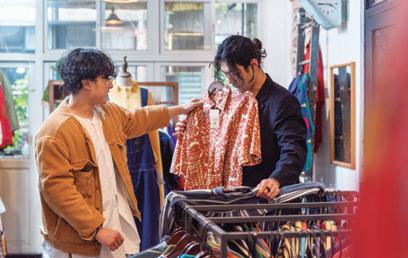

The Chifeng Street area just west of MRT Zhongshan Station, once busy with auto parts and hardware sellers, has emerged as one of Taipei’s two main enclaves for hipster vintage/ used-items shopping. The other is the area immediately west of MRT Ximen Station. At the top of the heap in the Zhongshan area is Mitty (www.mittygoods.com; Chinese), tucked away up on the second floor of a low-rise on an alley just off the corner of a neighborhood park (Jiancheng Park), reached via a stairway barely big enough for two passing. You’re directed in by a tiny sign sitting on cinder blocks that reads “Mitty – Vintage/Used/Select.”
The zesty second-level façade is constituted of 30 meters of vintage wood planks of far-more-thanrainbow variation. The treasures within range from American and Japanese apparel to digital games, toys, and action figures to sports and movie posters (esp. 1990s~2000s).
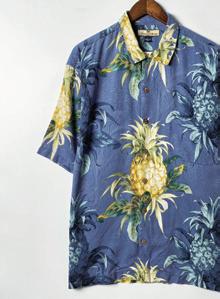
Waha Café (www.facebook.com/Wahacafe0417 ) is just around the tiny-block corner from Mitty. As you turn the corner you’re met with an explosion of plant life outside the shopfront, potted and hanging. The front itself is crafted of soothing light-hue stained-wood panels and a wide woodframe door, with liberal use of sun-inviting window glass. In the interior, long and narrow, the terrazzo flooring of the original residence Waha resides in has been left in place, and red-brick wall sections and thick woodbeam ceiling sections have been left exposed. The service counter plus another wall section are faced with rustic wood planking a la Mitty. The cuisine and drink are Western – coffees, teas, and other liquids, light foods such as sandwiches, quiches, salads, pastas, and curries with rice, plus rich desserts such as pies, cakes, and tarts.



This inventive designer enterprise (icleabag.waca.tw), creating leather and canvas daily-use items that are both fashionable and practical, is right on Chifeng Street just north of Mitty and Waha Café. The premises are both a retail outlet and a work studio. The shopfront is warmly inviting, with the ambiance of a small European forest cottage, complete with a vintage-style wood-frame sash window. Customers can choose from completed display items or have custom-created works crafted.

The range of merchandise includes a carry bag, apron/smock, automobile accessories, and outdoor-use series. Among the more out-ofthe-ordinary imaginings for a designer-crafts studio is a smock loaded with pockets and straps for tool storage (apron/smock series), a trash container and a tissue-paper case (automobile accessories), along with a hand-strap connector for tool-use safety and a tree/fence/etc.-hangable paper-towel roll dispenser (outdoor series).
Our final three destinations are all located right beside Xinzhongshan Linear Park, in tight mutual proximity. Petit Pot Cake (www.petitpot.com.tw) is a French-style patisserie (with two sister outlets in Taipei) that would look right at home on a quiet Paris neighborhood street, sporting an elegant Europeanstyle storefront with the color black prominent and a genteel interior with dark-stain wood prominent. Its cultural-creative calling is to bring distinctive Taiwan flavors to its pastries; only top-quality ingredients are used. In addition to its European-culture offerings, it also has Japanese-style sweet things, the most popular being the Showa-style caramel custard pudding.
A listing of just a few of the delicious names on the shop menu will give you a taste of the decision difficulty you are in for: Basque Cheesecake, Caramel Walnut Cake, Rum Raisin Sandwich Biscuits, Blueberry and Grape Swiss Rolls, Honey Madeleines, and Macadamia Nut Taiwanese black sugar tarts.
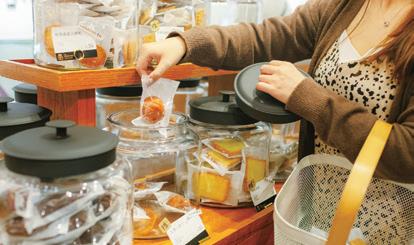

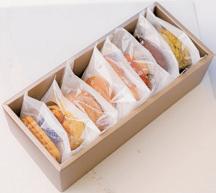


Taiwan folk love their mian xian , or rice vermicelli, for breakfast, lunch, and dinner, and the twist at this establishment is mian xian rich with the freshest seafood jewels – something else culinary that the people of island Taiwan are enamored with. All the marine ingredients used are Taiwan-sourced, notably the famously plump and sweet oysters of Dongshi Township on the southwest coast and neritic squid from the Taiwan Strait’s Penghu Islands. The signature dishes feature mian xian with neritic squid. Note that each noodle-bowl serving comes with garlic and cilantro, which can be requested eliminated or reduced on ordering. Side dishes of garlic oysters, garlic squid, and spicy braised intestine are also available.
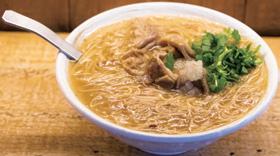
The eatery operations are all right at the sidewalk arcade, set up to resemble a Japanese yatai, literally “shop stand,” which are small, mobile food stalls. Patrons can sit on stools before the bar-like service counter or at metal drums-cum-tables painted up as Kirin Beer cans.
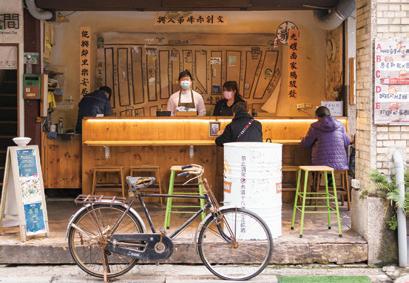

Cap off your productive day of Taiwan culture spelunking and healthy outdoor walking with a browse at this designer cocktail specialist. Its brethren outlet in Xinyi District has a dapper bar, but this outlet is more like a mini-mart. It’s inside the concrete-walled former residence that Mian Xian Ding fronts. The cozy interior space has fridges stocked with a delicious circus of cocktails presented in hipster-colorful takeaway bottles and cans.
Local flavor ingredients are front and center, with provocative names such as Strawberry Yogurt Green Tea Sparkling Cocktail, Yuzu and Ginger Cocktail, Red Guava Cocktail, and Pomelo Elderflower Cocktail. The house signature potion creatively marries Taiwan-icon Paolyta medicinal alcohol with dragon-fruit juice. Beyond the bottle and can selections, there’s also a mixing station with cups, soda water, and a variety of ingredient inputs that can be mixed and matched to construct your personal libation inspiration, along with a small selection of inventive edibles, such as Mango Colada Cocktail gummies.


ENGLISH AND CHINESE
Chifeng Street | 赤峰街
Datong District | 大同區
Dongshi Township | 東石鄉
Eslite Spectrum Nanxi | 誠品南西店
Icleabag | 點子包
Jiancheng Park | 建成公園
mian xian | 麵線
Mian Xian Ding 面線町
Mitty | Mitty 古著
MRT Zhongshan Station | 捷運中山站
Ri Xing Type Foundry | 日星鑄字行
Waha Café | 月霞
Wanhua District | 萬華區
WAT/Taipei Chifeng Branch | WAT 台北赤峰店
Xinzhongshan Linear Park | 心中山線形公園
Zhongshan Metro Mall | 中山地下街
Museum of Contemporary Art Taipei | 台北當代藝術館
Paolyta | 保力達
Petit Pot Cake | 小罐子點心舖


Whether you crave fluffy mountains of shaved ice, popsicles bursting with classic or novel flavors, or the delightful offerings of local icecream shops crafting creamy concoctions infused with adzuki bean paste, matcha, or even grass jelly, Taiwan has a frozen treat to suit your every whim. From time-honored indulgences to the latest innovations, these icy delights promise a refreshing respite from the scorching summer heat.
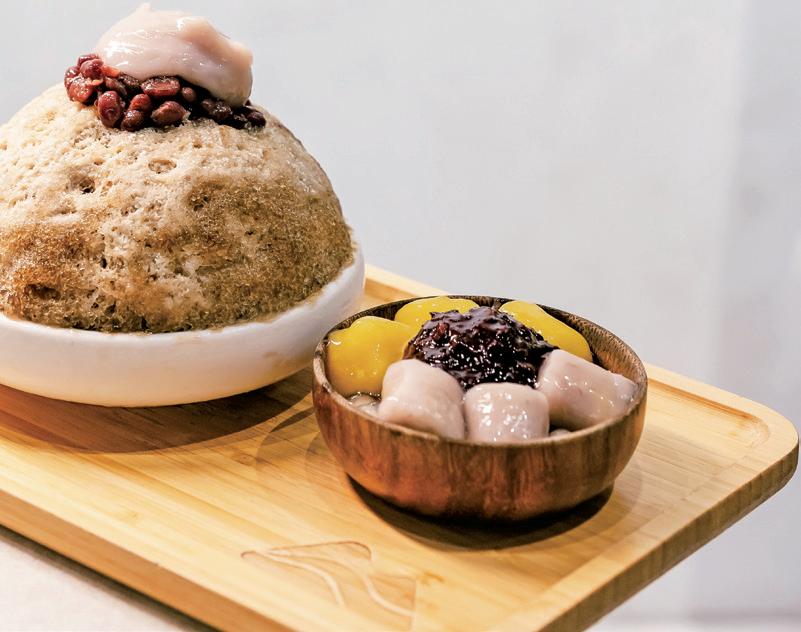
As Taipei's temperatures soar above 35 degrees Celsius, cool down with a selection of refreshing cool delights. Indulge in time-honored favorites such as shaved ice – tiny shavings meticulously trimmed from ice blocks straight into your bowl and adorned with a myriad of sweet toppings; treat yourself to popsicles crafted from cherished family recipes, passed down through generations; and explore the city's abundant offerings of creatively fashioned ice cream, each scoop a testament to love and innovation. Whatever your craving, you're never far from a satisfying frozen treat in Taipei.
Situated just a brief 5min stroll from MRT Zhongshan Station amidst a bustling shopping district, the Taipei Zhongshan branch of PaShih beckons with an industrial-inspired interior. Exposed-brick walls and concrete define its aesthetic, exuding an air of modernity. The space is characterized by clean lines and soft-toned hues, creating a calm and inviting atmosphere for patrons. Adding to the sensory experience is the subtle aroma of grass jelly permeating the air.
Since making its debut on the city of Taichung’s food scene in 2013, PaShih has garnered a loyal following of grass jelly connoisseurs in central Taiwan as well as in Taipei. It has also opened branches in Hong Kong. While initially the demand for grass jelly was not promising at its first store, in Taichung’s Fengjia area, PaShih persevered, driven by the team’s unwavering commitment to their craft and a profound passion for their creations.
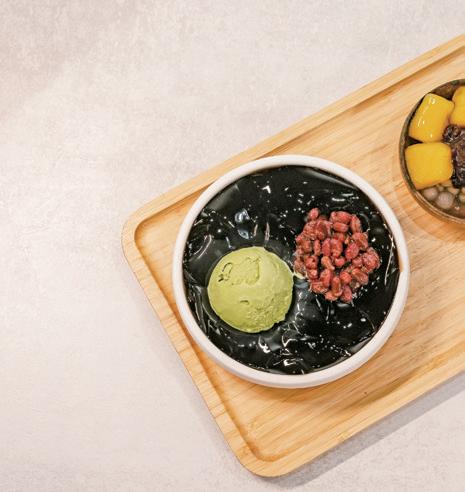
Grass jelly is made with mesona, a member of the mint family. To achieve its distinctive flavor profile, the herb is first dried, then slow-cooked for approximately eight hours with minimal ingredients added to allow its natural essence to concentrate and deepen. At PaShih, seasonal cold-months desserts are prepared to serve as winter warmers while refreshing ice-based treats take center stage in the warmer seasons, ensuring a delightful culinary experience year-round.
PaShih expertly blends its concentrated grass jelly with gelatin for a delicate texture that retains the full depth of aroma without any dilution. Despite its unassuming appearance, this humble dessert is rich and satisfying with every spoonful. In the winter, it is commonly served warm, accompanied by crunchy peanuts.
During the warmer months, PaShih prepares a variety of refreshing grass jelly iced treats. Among these offerings is a revitalizing grass jelly tea, which has a minty finish that provides instant relief from the heat and is ideal for those on the move. When seeking respite from the hot temperatures
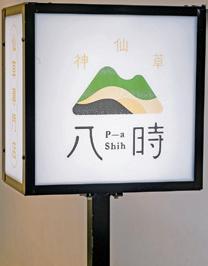
PaShih’s shaved ice is a marvelous concoction of subtly flavored grass jelly ice delicately layered atop a foundation of grass jelly. This towering mound of fluffy shaved ice boasts a uniquely soft and pillowy texture, striking a delightful contrast between the ice on top and the hidden grass jelly below.
The shop’s signature dumplings are a delightful combination of sweet potato and taro, delicately enveloping small spoonfuls of sticky black rice. The dumplings have a velvety texture and burst with the vibrant, natural flavors of the respective ingredients. Simply spoon this delectable addition into your grass jelly selection to enjoy the refreshing dessert even more.
Before leaving PaShih, consider buying a cup of cooling grass jelly drink to keep your body temperature comfortable while outside. And with each sip, you'll be reminded of the delectable experience you've just had at this place of full sensory satisfaction.
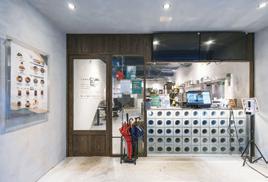

PASHIH ( 八時神仙草中山店 ) 0970 677 582
No. 5, Lane 135, Sec. 1, Zhongshan N. Rd., Zhongshan District, Taipei City ( 台北市中山區中山北路一段 135 巷 5 號 ) 12:30pm~9pm www.pashih.com.tw (Chinese) www.facebook.com/pashih.chifeng


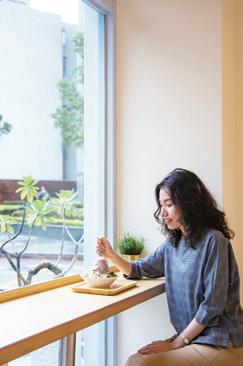
CHUN MEI ICE SHOP ( 春美冰菓室 )
(02) 2712-9186
No. 54, Lane 120, Dunhua N. Rd., Songshan District, Taipei City ( 台北市松山區敦化北路 120 巷 54 號 )

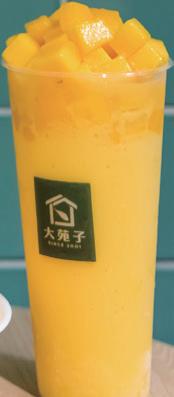
Found between MRT Nanjing Fuxing Station and MRT Taipei Arena Station, just off Dunhua North Road, Chun Mei Ice Shop has become a go-to destination for aficionados of delectable shaved-ice treats. Since its inception in the summer of 2017, the shop has been delighting patrons with its exquisite shaved- and snowflake-ice creations. Specializing in a variety of ice options, including pineapple shaved ice, sesame panna cotta atop ice, almond tofu served over ice, and taro shaved ice, it offers a culinary experience like no other. There is no English menu, but the friendly staff will help you with the selections. What sets Chun Mei Ice Shop apart is its commitment to crafting everything on-site and by hand, including the almond tofu and sesame panna cotta, showcasing its dedication to quality and authenticity.
Pineapple shaved ice is one dish you should try at Chun Mei Ice Shop. Sweet and tangy pineapple chunks are strewn atop a bed of traditional shaved ice, then adorned with delicate and wobbly aiyu jelly (made with the seeds of the creeping fig). This refreshing classic shares the “signature offering” spotlight with another masterpiece, a towering mound of milk-flavored snowflake ice generously coated in a velvety taro sauce – offering pure, earthy sweetness. Yet there’s more. Topping this off, chunks of taro, chewy taro balls, and a decadent drizzle of brown sugar and condensed milk complete this work of art.
12pm~9pm (Sunday until 10pm) www.instagram.com/chunmeiiceshop www.facebook.com/chunmeiiceshop
While Da Yung's is renowned for its delectable fruit-infused teas and other beverages, sold at its numerous branches in Taipei, what many may not realize is that it also offers seasonal shaved-ice treats and frozen yogurt. The enterprise is committed to sourcing premium fruits from dedicated farmers utilizing sustainable agricultural practices. Emphasizing the use of the freshest seasonal fruits, it implements strict safety standards, including a rigorous screening process for pesticides. Moreover, a logistics network has been established to ensure that fresh fruit is supplied to all outlets weekly, maintaining the highest level of quality and freshness in Da Yung’s offerings.
Located next to MRT Taipei City Hall station is the City Hall Dream Branch, where the predominant emerald-green interior color contrasts strikingly with the white wall tiles and light-wood finishes, exuding an air of sophistication. While the freshly prepared fruit boxes look enticing, you certainly don’t want to leave this shop without perusing the bilingual menu and ordering one of its renowned shaved-ice creations.
In the summer months, Da Yung's serves up a variety of refreshing treats crafted from fresh mangoes, such as mango smoothies, mango shaved ice, and mango green tea paired with almond tofu.

DA YUNG'S ( 大苑子市府夢想店 ) (02) 2768-0900 No. 139, Sec. 5, Zhongxiao E. Rd., Xinyi District, Taipei City (City Hall Dream Branch) ( 台北 市信義區忠孝東路五段 139 號 ) 11:00am~9:00pm www.facebook.com/dayungs.tw www.dayungs.com




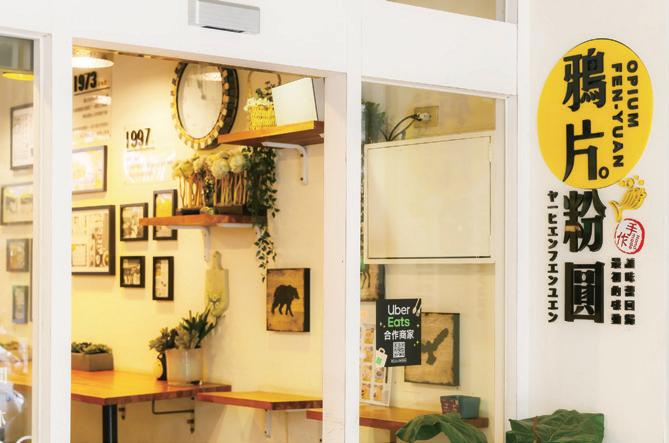
Just a short 2min walk from MRT Guting Station, in the student-popular neighborhood surrounding National Taiwan Normal University, Opium FenYuan has been a fixture in this location since 2016. Having multiple branches across Taipei City and New Taipei City, the operation is renowned for its traditional style of shaved ice graced with generous amounts of such typical toppings as tapioca balls, sweet potato balls, and adzuki/mung beans.





As you seek refuge from the heat outside, any item on Opium Fen-Yuan's menu promises to provide a satisfyingly cool respite. However, for the quintessential classic experience, opt for their signature bowl featuring tapioca balls, taro balls, sweet potato balls, and adzuki beans. The tapioca shaved ice comes highly recommended as well. With a bilingual menu available, ordering is quick and easy, followed up with a relaxing wait in the cozy and inviting interior while eagerly anticipating the arrival of your icy treasure.

Opium Fen-Yuan's tapioca shaved ice features chewy and soft tapioca pearls on top of a mound of shaved ice. The dish shines further with earthy adzuki beans alongside chewy taro and sweet potato, creating a pleasant textural contrast that is sure to excite your palate. Both options are a must-try for any shaved-ice enthusiast!
OPIUM FEN-YUAN ( 鴉片粉圓 ) (02) 2367-1587
No. 156, Sec. 2, Nanchang Rd., Zhongzheng District, Taipei City ( 台北市中正區南昌路二段 156 號 ) 11am~9pm (closed on Sunday) www.facebook.com/opium156

With a rich history dating back to 1947, Snow King proudly holds the title of Taipei's oldest-running handmade ice cream shop. Located in Taipei's vibrant Ximending area, not far from Taipei Main Station, this venture has been delighting patrons with delectable ice cream creations over multiple generations. Grabbing a seat by the window offers the perfect vantage point for an afternoon of people-watching from the second-floor shop while indulging in the highly innovative and deeply delicious ice cream.
Snow King has long been a trailblazer in the local ice cream world, pushing the boundaries of flavor innovation. It continually captivates and captures new loyal patrons with daring creations – the current menu sports offerings such as basil, watermelon, pork floss, and custard apple. The team’s greatness is evidenced by the acclaim they've received from notable publications like Forbes and The Wall Street Journal. Moreover, collaborations with prestigious brands such as Porsche and Kurisake have further solidified their reputation as pioneers in the industry.
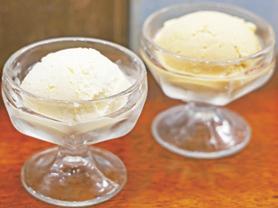

While embarking on a mission to sample the entire ice-cream menu at Snow King is highly recommended – there are scores of options –two standout options should not be missed: oolong tea and red wine. The oolong tea ice cream enchants with its smooth, milky texture and vibrant green tea notes, which sing throughout each creamy bite. The red wine option is special on several levels. Not only does it boast a fragrant aroma evocative of fine red wine, but the addition of wine-soaked raisins introduces a unique textural element, presenting little bursts of intense


SNOW KING ( 雪王冰淇淋 ) (02) 2331-8415
2F, No. 65, Sec. 1, Wuchang St., Zhongzheng District, Taipei City ( 台北市中正區武昌街一段 65 號 2 樓 12pm~8pm www.snowking.com.tw www.facebook.com/snowkingicecream
On a scorching day stroll along the riverside in New Taipei City’s Tamsui town, a 10min walk north of MRT Tamsui Station (the northern terminus of the Red Line), the relentless sun ignites a craving for delectable ice cream. While nearby vendors offer sweet and milky soft serves, it's LiAng Le that beckons with its homemade ice cream gems. You could opt for a classic cone adorned with up to three tantalizing scoops of ice cream, but the true standout is the peanut
LiAng Le offers a diverse array of icecream flavors catering to every palate, with options like matcha, sesame, taro,

peanut, guava, and adzuki bean. However, one especially recommended standout combination is peanut and taro. The creamy taro perfectly complements the earthy richness of the peanut, creating a harmonious blend. Topped with crunchy-sweet peanut brittle shavings inside the pancake roll, this combination is truly special. The occasional burst of freshness from cilantro adds another layer of complexity, giving you a toothsome mix of tastes sure to make you smile. As well, don't overlook the sesame and matcha combination; the nutty, earthy notes of the sesame beautifully contrast with the bitter undertones of matcha.
LIANG LE ( 倆樂花生捲冰淇淋 0920-097-763 No. 11, Ln. 11, Zhongzheng Rd., Tamsui District, New Taipei City ( 新北市淡水區中正路 12:30pm~6:30pm (Saturday/Sunday 12pm~8pm; closed on Tuesday) www.facebook.com/liangle0313
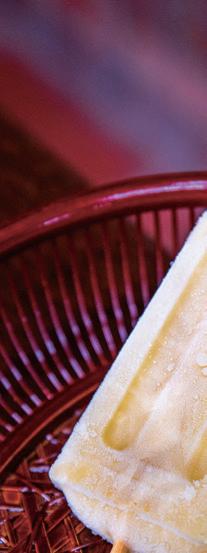






Situated just off a busy intersection a 5min walk from the Light Rail Tamsui District Office Station, 50s Popsicles of Tamsui is an iconic establishment that has been delighting patrons with its classic Taiwanese flavors for decades, drawing tourists from all corners of the island. Stepping inside feels like stepping back in time, as weathered wood, exposed-brick walls, and vibrant-red roof tiles create a charming and nostalgic ambiance. You'll be greeted by a menu with Chinese characters elegantly carved into hanging sections of bamboo. (There is no English menu.)
While the array of choices can be overwhelming, trying the house special ( qing bing ; a traditional ice made with banana oil), dong ding tea, or plum popsicle is a good starting point. The mellow and intriguing qing bing popsicle is especially cherished by many for its timeless appeal. Crafted using timehonored methods, each popsicle of 50s Popsicles of Tamsui carries decades of tradition in every bite, ensuring a satisfying experience no matter which flavor you choose.
50S POPSICLES OF TAMSUI ( 淡水舊鎮 50 年代枝仔冰 ) (02) 2625 2267
No. 270-1, Sec. 2, Danjin Rd., Tamsui District, New Taipei City ( 新北市淡水區淡金路二段 270-1 號 ) 11pm~6:30pm (Saturday/Sunday 10pm~7pm) www.facebook.com/fifty.year.gab
ENGLISH AND CHINESE aiyu | 愛玉 dong ding tea | 凍頂茶 Fengjia | 逢甲 grass jelly | 仙草 National Taiwan Normal University | 國立臺灣師範大學 qing bing | 清冰 Ximending | 西門町



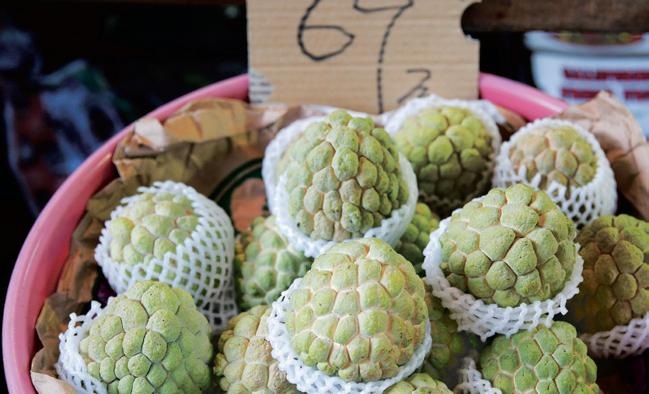


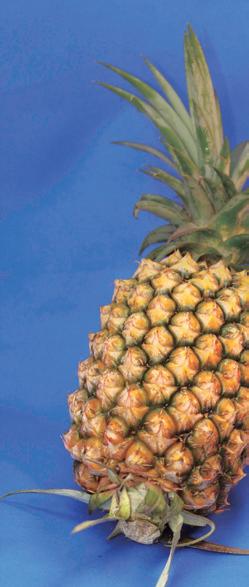




Seasonis key when shopping for the freshest of fruit, and it’s therefore best to learn about Taiwan’s fruit seasons and areas of cultivation before going to a day market or a fruit shop.
Below is an overview of the peak times for fruit harvests (some fruits can be harvested in more than one season, or even year-round).

European plum (李子)
Japanese plum (梅子)
Loquat (枇杷)
Avocado (酪梨)
Dragon fruit (火龍果)
Longan (龍眼)
Lychee (荔枝)
Mango (芒果)
Passion fruit (百香果)
Peach (桃子)
Pear (梨子)
Watermelon (西瓜)
Grape (葡萄)
Persimmon (柿子)
Pomelo (柚子)
Roselle (洛神)
Star fruit (楊桃)
The conditions for cultivating fruits vary wildly depending on the location in Taiwan, and there are certain areas particularly suited for growing one type of fruit. Some townships or districts around the island are especially famous for one particular fruit. For example, Tainan City’s Guanmiao District is well known for its pineapples; Yujing, also in Tainan, for mangos; Lalashan in Taoyuan City for peaches; Xinyi Township in Nantou County for plums; high-mountain Lishan in Taichung City for apples and pears; Dahu Township in Miaoli County for strawberries; and Kaohsiung City’s Qishan District for bananas.
There are so many fruits produced in Taiwan to choose from – what are the most popular ones among the locals? Usually at the top of any list ranking Taiwan’s most popular fruits is mango, and among the more than 20 mango varieties cultivated here, it is the Irwin mango that super-sweet-and-juicy-

Honey jujube (蜜棗)
Jujube (金棗)
Mandarin orange (柑橘)
Small tomato (小番茄)
Strawberry (草莓)
Tangerine (柳丁)
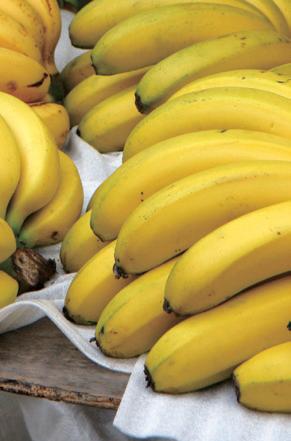
All Year
Banana (香蕉)
Custard apple (釋迦)
Guava (芭樂)
Kiwi (奇異果)
Papaya (木瓜)
Pineapple (鳳梨)
Wax apple (蓮霧)
for mango is the summer, strawberries are harvested in the winter in Taiwan. During the harvest season, many strawberry farms welcome visitors who wish to self-pick their fruit, a fun wintertime activity.
Among the most common and typical fruits available year-round are papaya, pineapple, guava, and banana. At the other end of the spectrum is a surprising number of niche fruits that have been successfully introduced from abroad in recent years and are now cultivated in small quantities by individual farmers. Among these are the Peruvian groundcherry, star apple, black and white sapote, gac, Chinese chestnut, abiu, wampee, jabuticaba, and jackfruit.
If you’re interested in learning more about Taiwan’s fruits and perhaps would like to visit a recreational farm that allows you to go into an orchard and pick for yourself, visit the Taiwan Fruits Travel website: ezgo.ardswc.gov.

(Agency of Rural Development and Soil and Water Conservation, MOA).


Stringy, chewy, and delicately savory, mianxian, or wheat vermicelli, is one of Taiwan's most popular types of noodles. Though most mianxian on the market is mass-produced using modern machinery, the chewiest noodles are the ones still made the old-fashioned way. In the mountains southeast of Taipei City, one artisan, Hsu Jen-ping, has been making small-batch hand-pulled mianxian for almost thirty years.
As we leave Taipei City and head east into the mountains, the clouds promise rain. We pass through Shiding – a quaint village straddling a winding gorge-bottom river – now heading southeast, and begin to climb an ever steeper, ever more twisting mountain road, scattered with the tung blossoms of late spring. Following a fork with a sign for Hsu's Noodle, the clouds break, and as we pull up outside the small workshop we are greeted with the sight of mianxian, draped over wooden frames, shining like golden hair in the sun.
Most visitors to Taiwan will likely encounter mianxian as part of the famous oyster vermicelli - roasted mianxian topped with oysters, garlic, and coriander in a thick, starchy soup – which can be easily found at day markets and in night markets around Taiwan. This is, however, far from being its only culinary application, one other particular local favorite being mianxian served with ham hocks as an auspicious birthday meal, the long noodles symbolizing long life.
Mr. Hsu, a stocky man in early middle age sporting an orange bandana and a warm smile, greets us in the courtyard of what was his childhood home, now a welcome area for visitors, beside which is the small production area – a simple corrugated-iron-roofed building Hsu set up in 1996 after deciding that making hand-pulled mianxian was his calling.
“My family originally were tea growers,” Hsu says, “but when still young I already knew that I didn't want to go into the teaproducing business. Picking tea is tedious, back-breaking labor.” So, after graduating from junior high school, Hsu apprenticed with his neighbor, a mianxian producer, from whom he learned the tricks of the noodle-making trade. “After two years of learning to make noodles, I went back to finish my education and got a job as a technician fixing banking machines. After a couple of years of that, though, I felt I was in a rut.” At a loss for how to increase his prospects, Hsu sought advice from his former master, who, perhaps unsurprisingly, suggested he start his own noodle-making business. Convinced, and with his family’s blessing, Hsu added a small workshop as an extension to his family home and began producing mianxian the traditional way.



“My
family originally were tea growers, but when still young I already
knew that I didn't want to go into the tea-producing business.
Picking tea is tedious, back-breaking labor.”
For Hsu, the eight-to-nine-hour process of making mianxian starts before dawn, when he and his small team prepare the dough – a mixture of water, salt, and plain wheat flour – before kneading and pressing, a process which Hsu completes using circular wooden boards and his body weight, pounding the top board with his feet to compress the dough sandwiched between. He then takes a hooked knife and, starting at the outer edge, cuts this dough pancake into a spiral until it resembles a pale, coiled snake. These coils, about the thickness of a man’s arm, are then unwound, rolled until their diameter is more akin to that of a finger, and finally looped around two metal poles in a figure-of-eight. The next and penultimate step before the final drying is the pulling of the noodles, and this is one that visitors to the workshop can try out for themselves.
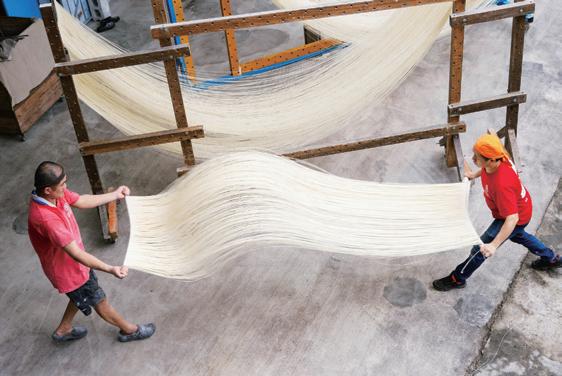
Pulling the noodles requires two people. One holds the two metal rods around which the noodles are looped. The other takes a third metal rod, places it between the strands at their lowest dipping point, and, holding onto both ends, takes a few paces backward. Then, facing each other with the noodles slack between them, the two engage in a rhythmic back and forth whereby the noodles are alternately stretched and relaxed with jerky, undulating motions. It’s this specific technique, Hsu says, that gives hand-pulled mianxian their superior texture –which in Taiwan is known as “Q” (a bouncy, chewy mouthfeel beloved by the Taiwanese and familiar to anyone who has chewed on the tapioca pearls in a Taiwanese bubble tea).
When Hsu started making noodles, it was a two-person operation – just Hsu and his father, who were able to process around five sacks of flour a day. Almost thirty years later, the number of staff has increased, but the production scale remains relatively small, with only around 20 sacks of flour being processed per day at peak times. However, with such a limited output, quality control is of course extremely high, in part because of the care that Hsu puts into his production, but also because of the location. “The recipe for mianxian is so simple –water, salt, and flour,” Hsu says, “that the quality of the water is incredibly important and has a big influence on the noodles' texture, as does the air quality for when we dry the noodles in the sun. Being outside of the city, in the mountains, so close to the natural world, we can avoid any pollutants adulterating the texture and flavor of our noodles.”
“The
recipe for
mianxian is so simple –water, salt, and flour – that the quality of the water is incredibly important”

After pulling the noodles, visitors can test the “Q-ness” of Hsu's mianxian for themselves. At the rear of the courtyard, four water chutes are set up with benches arranged alongside. At Hsu's instigation, mouthfuls of noodles are sent sliding down the chutes at regular intervals. Participants take a pair of chopsticks and try to catch them as they whoosh by. The process begins with plain noodles, but after a few mouthfuls have passed, the plain noodles are followed by pink ones – flavored with red yeast – and soon after that by green ones – flavored with green tea. The flavors are subtle, but indeed, the texture is what stands out – chewy and bouncy, with a mildly fermented aftertaste, a truly pleasing mouthfeel.
Visitors are free to show up any time during opening hours, but to take part in the activities (pulling noodles: NT$300 per person; water chute noodles: NT$250 per person), Hsu recommends booking ahead of time. Packets of the noodles in all three flavors are also available for purchase at just NT$75 each – one packet contains two portions. To get to the workshop, having one's own transportation (such as a taxi or rental car) is best; however, it is possible to take the number 666 bus from MRT Jingmei Station (Green Line of Taipei Metro) to Shiding, and to walk the 3km uphill from there (while the trek may be strenuous, the views of deep valleys and the surrounding mountains are quite stunning). Alternatively, trips to Hsu's Noodle can be booked as part of daytrip packages by various local tour companies.
HSU'S NOODLE ( 許家麵線 ) (02) 2663-3004 No. 3, Sifenzi, Wutu Borough, Shiding District, New Taipei City ( 新北市石碇區烏塗里四分子 3 號 ) www.facebook.com/sdnoodles
ENGLISH AND CHINESE (oyster) mianxian | ( 蚵仔 ) 麵線 Shiding | 石碇 MAP




Taipei City FOOD
Grand Hotel Taipei
圓山大飯店
Enjoy a glass of wine specially made for heads of state and breathe in the air of history and culture at Meet bar.
Based on ideas by Madame Soong Meiling, the Grand Hotel Taipei was established in 1952. The first five-star hotel in Taiwan, it became a must-stay hotel for distinguished guests visiting the island and a cultural landmark of historic significance. The Chinese name of Meet bar is a play on words. Mi Dao sounds like “To Find” as well as “Secret Passage.” The bar combines old and new spaces and thus symbolizes the Grand Hotel’s presence and past. From Meet bar walk through the historic Secret

East Passage to find a secret garden and take a look into the Old Residence of Kung Ling-wei (daughter of Nancy Soong Ai-ling). Then return to the bar, order a unique “Red House” cocktail and reminisce about times gone by. Meet bar reservation hotline:
9am~4pm Tel: (02) 2886-1818 ext. 1281 4pm~1am Tel: (02) 2886-1818 ext. 1998

No. 1, Sec. 4, Zhongshan N. Rd., Zhongshan District, Taipei City ( 台北市中山區中山北路四段一號)
Tel: (02) 2886-8888 Fax: (02) 2885-2885 www.grand-hotel.org
台北怡亨酒店
Setting the benchmark in terms of style and inspiration, staying at Hotel Éclat Taipei is no ordinary experience. Situated in the fashionable district of Da'an, this charismatic boutique hotel with its avant-garde design, attentive service and astounding modern art collection is nothing short of leading-edge.



No.370, Sec. 1, Dunhua S. Rd., Da'an District, Taipei City 106, Taiwan ( 台北市大安區敦化南路一段370號)
Tel: (02) 2784-8888 Fax: (02) 2784-7888
Reservation: (02) 2784-8888
https://www.eclathotels.com/taipei

STAY
Taipei City
Experience elegance at MGH Mitsui Garden Hotel, a new landmark in Taipei.
The interiors celebrate Taiwan’s natural beauty with exquisite local artwork, and each guestroom offers tranquility and exceptional Japanese craftsmanship. Unwind in the hotel's top-floor Japanesestyle bath with panoramic city views.
Start your day with a delectable buffet breakfast made from the freshest local ingredients.
Discover the perfect blend of luxury and cultural artistry at MGH Mitsui Garden Hotel.

No. 30, Sec. 3, Zhongxiao E. Rd., Da'an Dist., Taipei City, 10652
MRT: MRT Zhongxiao Xinsheng Station (Blue and Orange lines)
Tel: (02) 2781-1131
SNS: @mghmitsuigardenhotel
E-mail: tpezhongxiao@gardenhotels.com.tw
STAY
Taipei City
Sparkle Hotel is just steps from Exit 3 of MRT Taipei 101/World Trade Center Station on the Taipei Metro Xinyi Line, directly across from Taipei 101 and the Taipei World Trade Center. It is separated from Taipei's popular and fashionable Xinyi Shopping District only by Xinyi Road. Featuring a classic and stylish design, the hotel offers 28 exquisite guestrooms, providing a comfortable space to relax physically and mentally during your stay in the city. Step outside and you will see Taipei 101. Walk just 2 minutes to enter the MRT station. Sparkle Hotel offers the most convenient location for your stay in Taipei.
No. 16, Sec. 5, Xinyi Rd., Xinyi District, Taipei City ( 台北市信義區信義路五段16號)
Tel: (02) 2723-0999 www.sparklehotel.com.tw


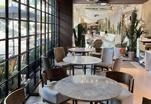

New Taipei City
North Coast and Guanyinshan National Scenic Area
北海岸及觀音山國家風景區管理處
Guanyinshan (Mt. Guanyin) is renowned for its vibrant ecology and enchanting mountain landscapes. In addition to its seven natural hiking trails, the area boasts historical and cultural sites, intriguing topography, a rich avian ecology, and numerous other natural resources. This is a delightful playground for nature enthusiasts, ideal for outdoor activities such as birdwatching and hiking. Guanyinshan serves as a vital habitat for birds of prey. The most notable of these birds include the Chinese sparrowhawk,
gray-faced buzzard, crested goshawk, and crested serpent eagle. The annual HawkWatching event on Guanyinshan is a significant occasion for the local bird-watching community drawing numerous birders each year. With the growing global awareness of sustainable tourism, the North Coast and Guanyinshan National Scenic Area administration advocates for mountain and forest tourism that leaves minimal traces. Visitors are encouraged to use public transportation when traveling to the beautiful North Coast!
Hualien County TRAVEL BUY
印象花蓮手工皂

No. 33-6, Yuankeng Rd., Xiayuan, Shimen District, New Taipei City ( 新北市石門區下員坑路33之6號)
Tel: (02) 8635-5100
www.northguan-nsa.gov.tw


In collaboration with the Ruisui Township Farmers' Association, Hualien Soap has developed a method to extract wendan pomelo essential oil and use the oil’s exceptional cleansing and antibacterial properties to craft natural antiseptic handmade soaps. The soap-making process also involves incorporating highquality produce sourced from the East Rift Valley and the East Coast. It takes about 60 days to produce the soap, using a cold processing method. Applying continuous refinement and patience, each new type of soap takes nearly a year to be perfected. Hualien Soap's handmade soap features
natural ingredients, is gentle on the skin, and is environmentally friendly. Approximately 24 hours after contact with water, the soap decomposes into water and carbon dioxide, flowing into rivers and the ocean without harming the ecology. This process helps keep the earth beautiful, clean, and free of harmful elements.

No. 13, Zhonghua Rd., Hualien City, Hualien County ( 花蓮縣花蓮市中華路13號)
Tel: (03) 833-7777
www.hualien-soap.com


